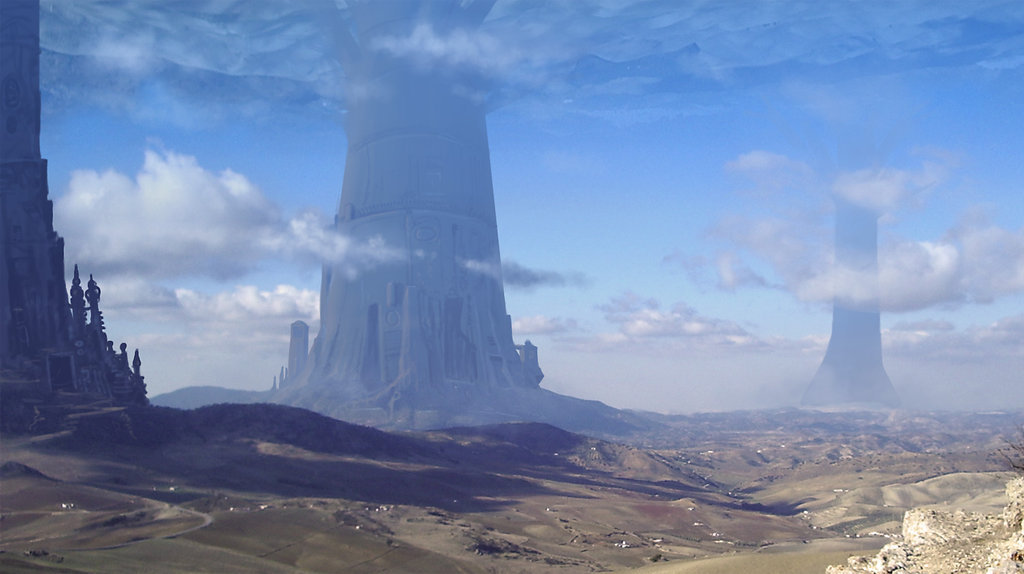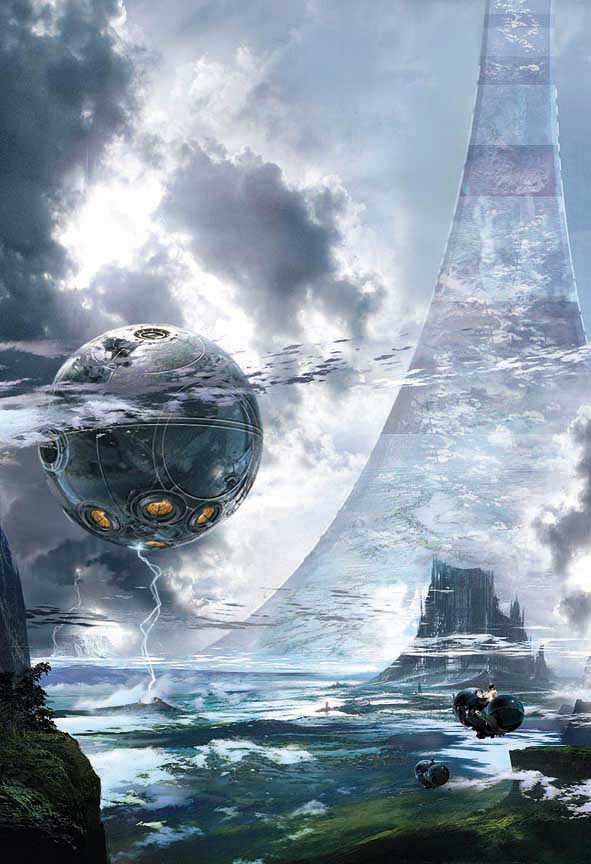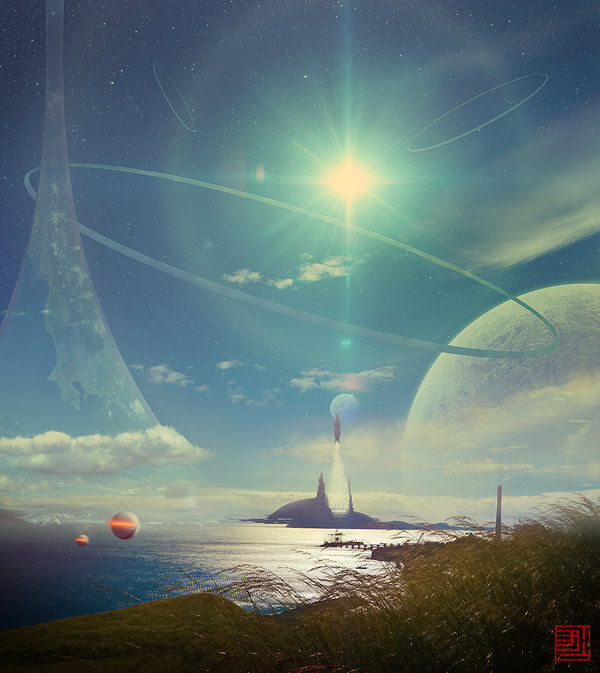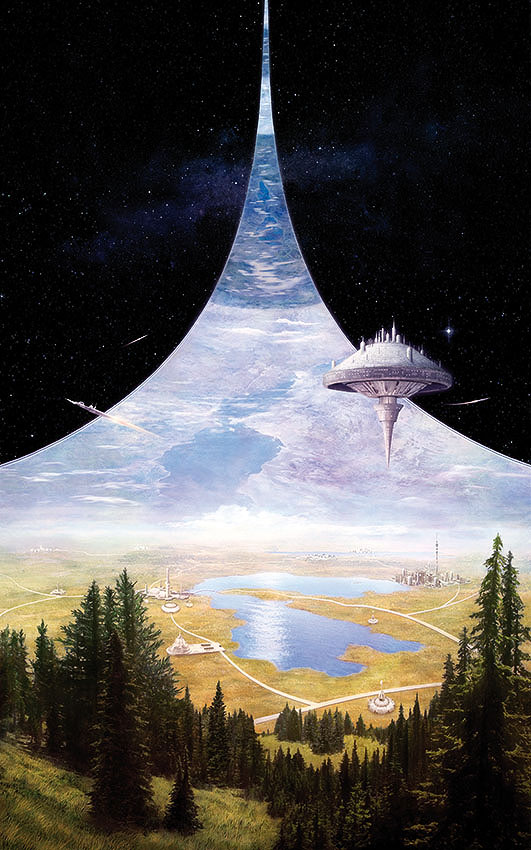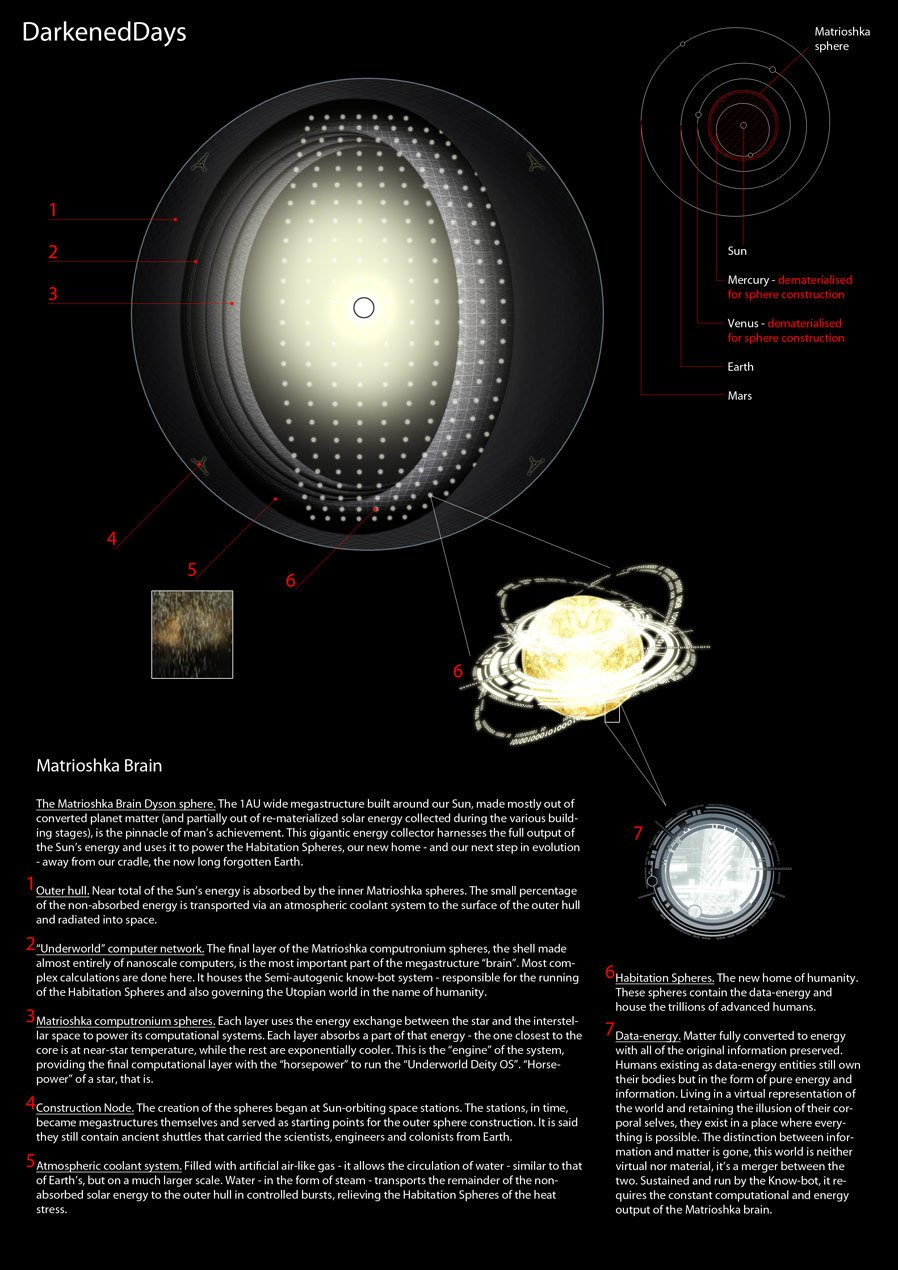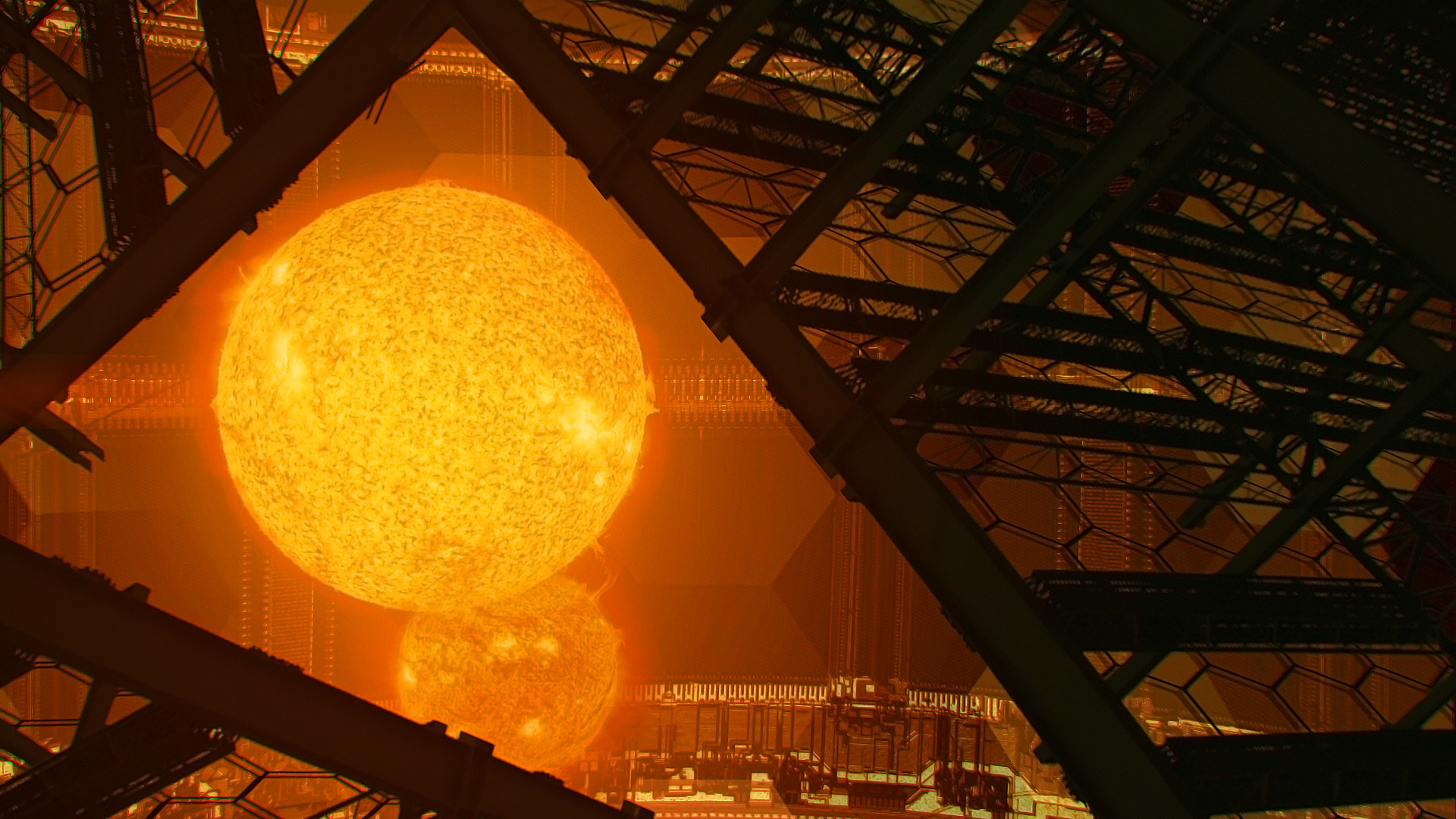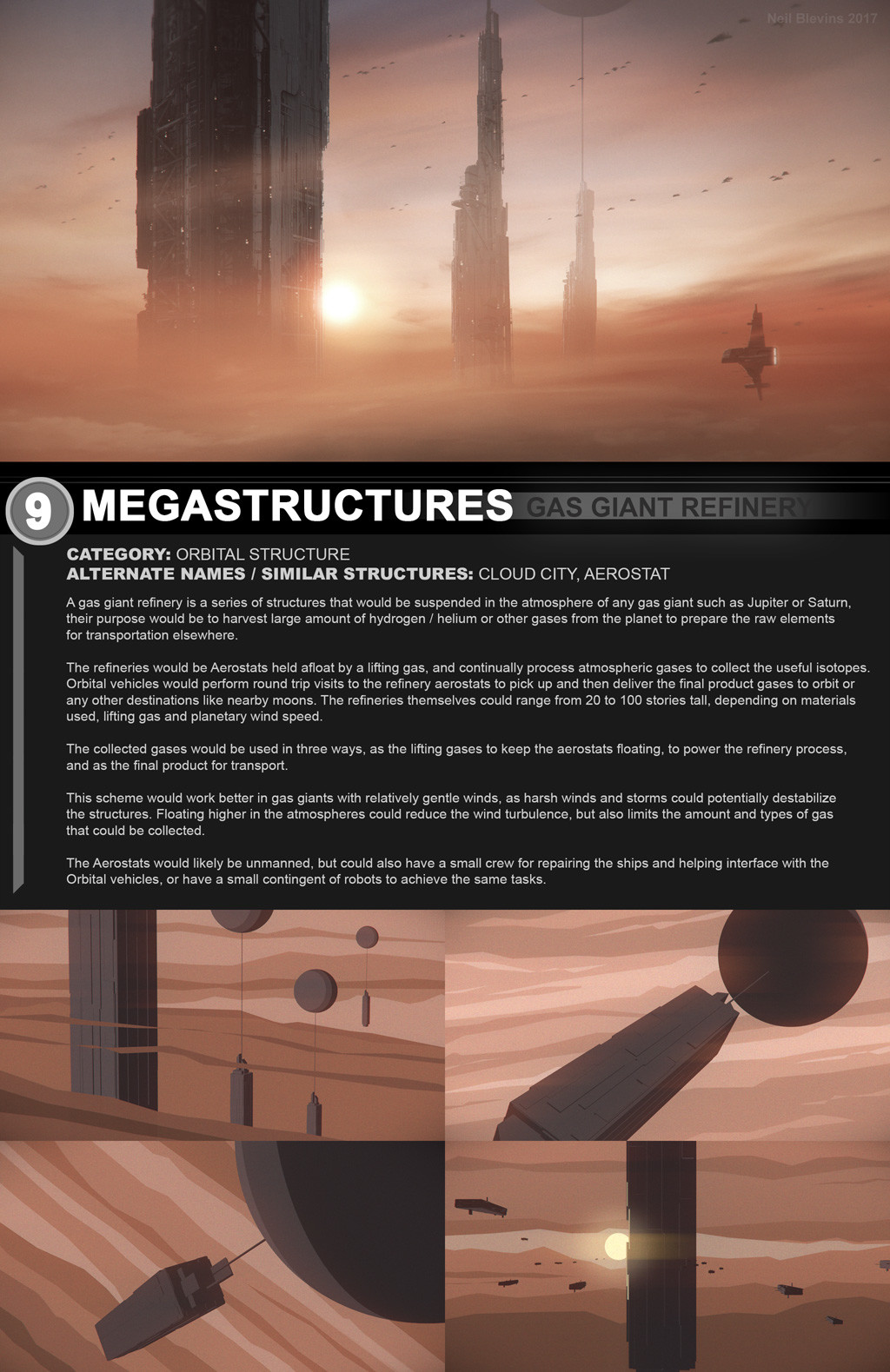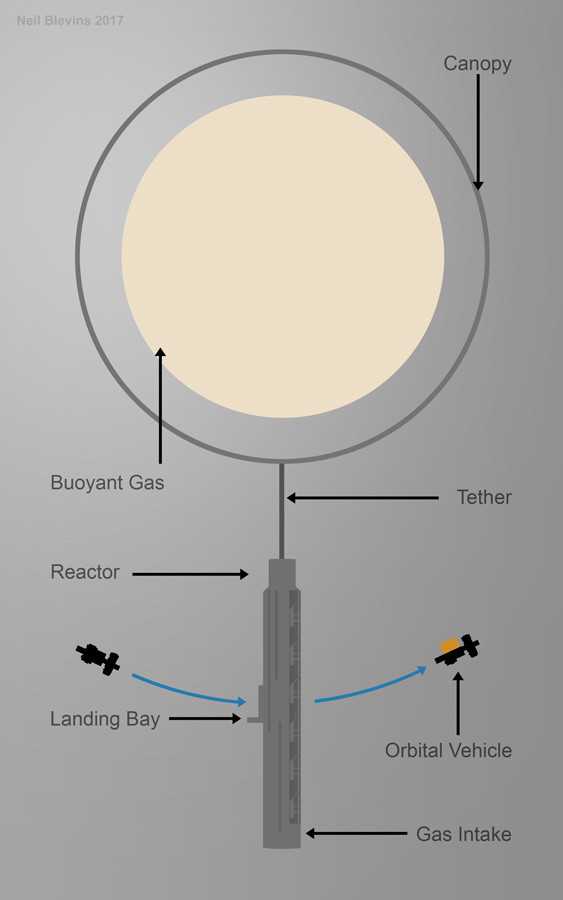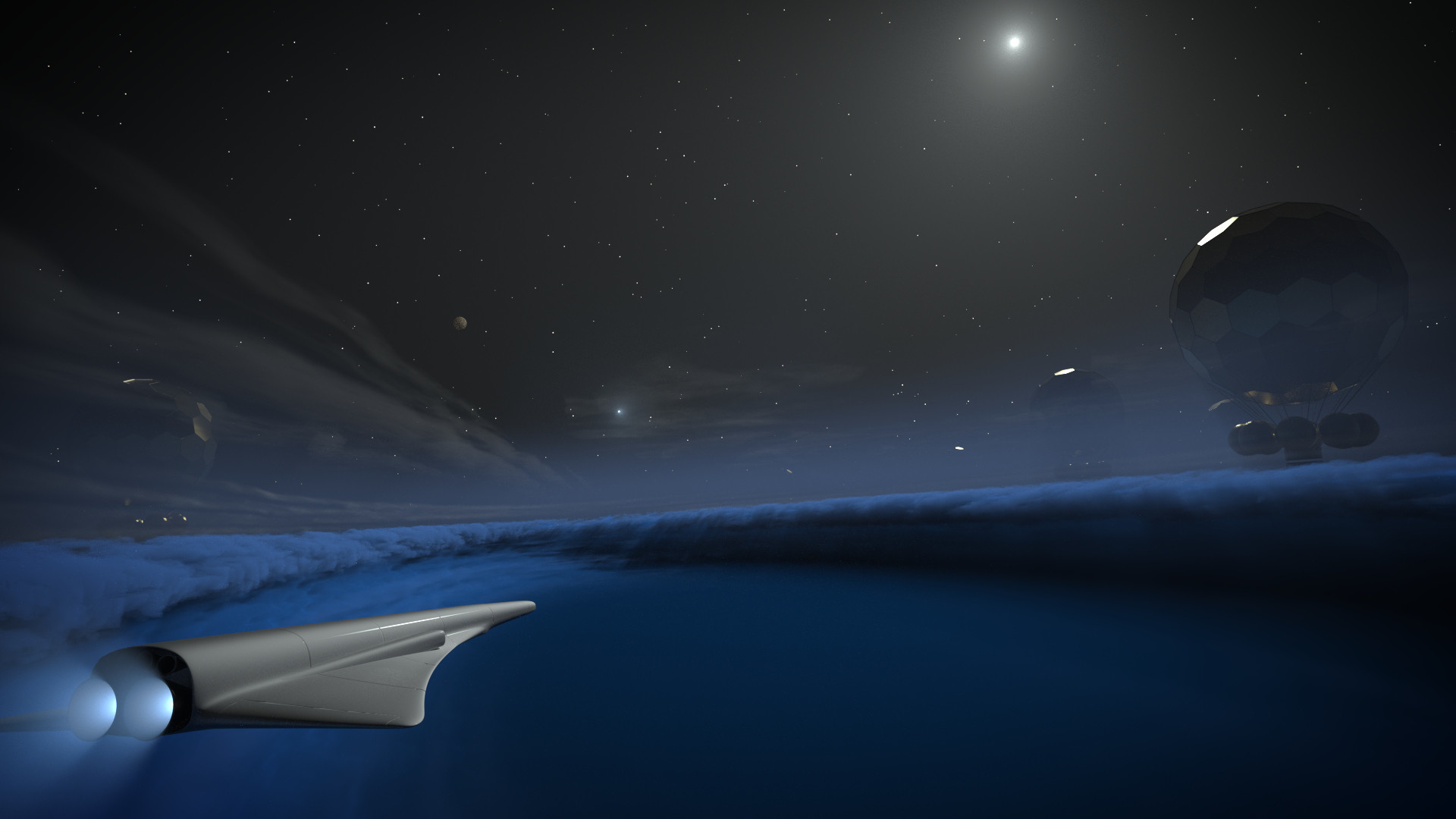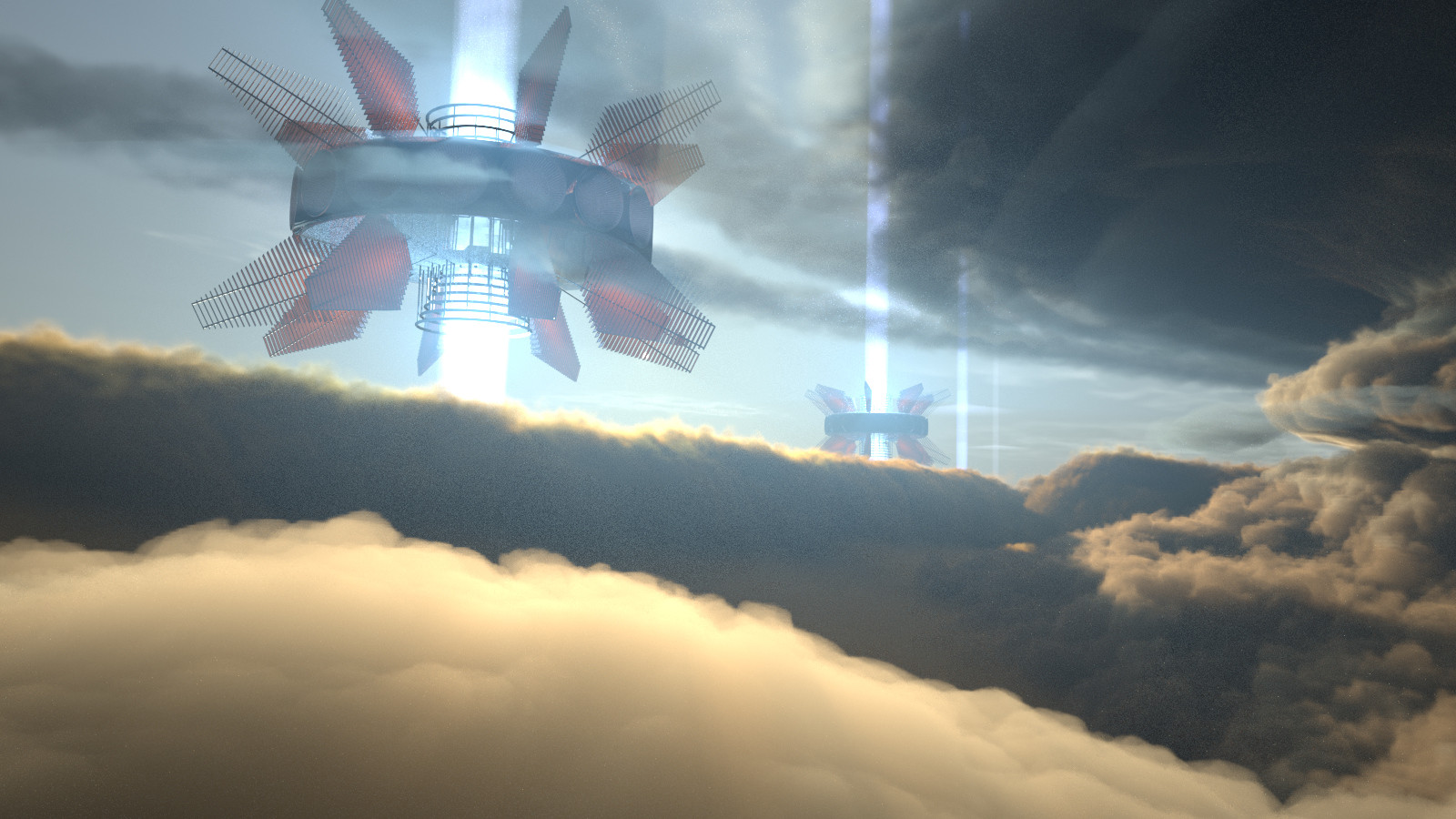“Science is a collaborative enterprise, spanning the generations. When it permits us to see the far side of some new horizon, we remember those who prepared the way—seeing for them also.”
Overview
Today, we're going to learn about orbital rings. Basically, an orbital ring is just a giant ring that would surround our planet. We'll learn that orbital rings are the prelude to space and the complete colonization of our solar system in particular. Today, it is very expensive to go to space; this is because, with present methods, we must use big bulky rockets that consume a lot of fuel to get something to space. Indeed, in the year 2021, a 12-day stay in a space hotel might cost $9.5 million. But with an orbital ring, all of that changes. If we had an orbital ring, we could send people to space for a cost comparable to that of a plane ticket. This would cause quite the boom in the space tourism industry.
For the first time in our species history, millions and eventually billions of us would be commuting between Earth and space every year due to the ultra-low cost to go to space. With all of those people and cargo going to space, you would need to build a lot of new living space and facilities up there. Those living areas and facilities could be megastructures like the Standford torus or the Bernal sphere; those megastructures could accommodate up to 10,000 people each. But we'd have so many people going to space that it would also make sense to build things like the O'Neil cylinder, a type of megastructure which can accommodate up to several million people. To conclude what has been discussed up to this point: today, going to space is expensive, and thus not many people or cargo go there; in the future, with an orbital ring, going to space would be cheap, and thus you'd have a lot of people and cargo going there; because you'd have a lot more people and "stuff" going there, you'd need to build more living spaces and facilities up there (which is where the Standford torus, Bernal sphere, and/or O'Neil cylinder could come into play).
Also—and this is a slight tangent—but this would give us another good reason to go back to the Moon. As originally outlined by the physicist Gerard K. O'Neil, we could build O'Neil cylinders (and the orbital ring and other megastructures) using materials from the Moon and asteroids. O'Neil wanted to build a mass driver on the Moon exactly for this purpose. A mass driver is a kind of launch system and rail gun which would allow us to launch lunar materials into space where they could be used to build stuff like orbital rings and O'Neil cylinders in space. But a mass driver could also be used as a propulsion system to move asteroids to locations near the Earth where they could be subsequently mined for there resources. Indeed, we discussed in a previous article entitled, Colonizing the Asteroids and Comets of our Solar System, how these objects could be hollowed out and then, after hollowing them out, we could build rotating cylindrical habitats inside of them. These would be the O'Neil cylinders—though, for aesthetic and visual purposes, most images portray O'Neil cylinders which are not surrounded by asteroids. But with all of that said, once you've got those orbital rings built, you'll be sending a lot of stuff to space and you'd have a lot of extra buildings and cities to keep all that stuff.
But what would we humans do after that? It turns out that the answer would be to, inevitably and certainly, go on to colonize the entire solar system, and then the entire Milky Way galaxy, and then other galaxies as well—though, in this article, we'll be primarily focused with how orbital rings would be used to colonize the solar system. Now, notice that I said that this would be inevitable and certain. What are the reasons and arguments which would justify me saying that? It turns out that there are three. The first, is purely economic—there's a whole lot of wealth to be acquired out there in space. The second, is biological—exploration has quite literally and physically, been hardwired into us as an essential element to our survival. The third and perhaps most important, is survival—as we've discussed in many other articles, the universe is a pretty dangerous place and is trying to kill us all the time with asteroid impacts and nearby supernovae. And so, in order to avoid or nullify those threats, we must spread more and more outwards across space.
Indeed, many have argued that the fact that we have become a danger to ourselves is a reason for us going to space. And that fact right there ties in with some other uses of orbital rings which we'll cover in this article: namely, you could use these orbital rings to help combat global warming and to cool the planet; you could use them to power all of the worlds cities with renewable, non-intermittent power for as long as the Sun is still shining; and, as once conceived by the great Nikola Tesla more than one century ago, you could use them as an ultra-fast, ultra-energy-efficient, and ultra-clean global transportation system. All of those perks are in addition to the orbital rings main use which would be to send things cheaply from Earth to space and to use the orbital ring as a launch system to launch things across the solar system, and perhaps beyond.
But, I'd like to bring things back to what we were talking about before: using orbital rings to colonize the solar system. How would that work? Well, the nice thing about orbital rings is that you can build them around almost any massive body including planets, moons, stars, and even black holes. So, you could build these orbital rings around Jupiter, Saturn, Uranus, Neptune, and the Sun for example. Another thing that's nice about orbital rings is that you can build bunch of them side-by-side until they start looking like a sphere (albeit, one with gaps); but then, after that, as the scientist Paul Birch explained in his papers, you could use those orbital rings to support a spherical surface. Now, what you'd want to do is to build the rings and that spherical surface out to a distance away from the central massive body (i.e. the Sun or Jupiter) where gravity is the same as Earth. (Recall that gravity varies inversely with the square of the distance away from a massive body: go closer to that body, the gravity gets stronger; go further out, and that gravity weakens.) You could build cities and an atmosphere and have lifeforms on the surface of that sphere and they would all be held there and glued to that sphere's surface by its gravity. In conclusion, basically what you'd have is an artificial planet (that surrounds a real planet or even something else like a star for example) with Earth-like gravity and Earth-like features. These artificial planets are called supramundane planets. Another nice thing about orbital rings is that you can build many orbital rings around a mass, but have those rings be of different sizes. This would allow you to build differently sized shells with different radii around a massive body. This is called a shell world.
With the use of this method of shelling over worlds, as well as other methods like building artificial space habitats (i.e. the O'Neil cylinder) and terraforming planets, you could effectively colonize the entire solar system. That is something which we'll discuss in great detail in this article. Building something like a supramundane planet or a shell world around any of the four gas giant planets in our solar system would be especially useful. This is because we could attach vast mega-skyscrapers to the "ceilings" of such artificial worlds and use them to extract useful materials like Helium-3 and deuterium from the gas giant's atmosphere. These types of mega-skyscrapers are known as gas giant refineries. That Helium-3 and deuterium which we extract from the atmosphere could be used as fuel for interstellar arcships headed off to all the other "nearby" star systems. We will discuss the topic of vast interstellar and intergalactic migrations a little bit, but that'll be saved mostly for the next article which will focus mostly on star lifting and its implications. Back on topic though, those gas giant refineries could be used to gradually extract most of the materials in that gas giant's atmosphere.
Using these refineries, and other methods, you could eventually completely strip the gas giant planet of its atmosphere. After doing that, what would you be left with? It turns out that, to put things basically, gas giants consists of mainly two different parts: a gaseous outer-atmosphere which comprises the majority of the planet (for this reason, you cannot stand on the ostensible "surface" of a gas giant) and a rocky inner-core. You can think of gas giants as, roughly, a rocky, metallic, kind of Earth-like planet trapped underneath a thick haze of gaseous atmosphere. But using these gas giant refineries and perhaps other methods as well, you can remove that gaseous atmosphere and what you'd be left with is a planet that is kind of Earth-like; indeed, with the appropriate modifications, it could be made much more Earth-like. We also discuss using fusion candles to move those gas giants into the continuously habitable zone (aka the goldilocks zone) of its parents star. Thus, what you could do is convert these gas giant planets into Earth-like planets. Ideally, you'd want to live on the artificial shell surrounding that gas giant planet for as long as possible. As the planet gets smaller as you remove more and more of its atmosphere, you could have your artificial shell contract to maintain the Earth-like gravity on its surface. Eventually though, that gas giant would keep on shrinking and, eventually, it would be desirable to live on its husbanded and eventually terraformed Earth-like surface.
Alternatively, you could just live on the Sun. Not literally as in on its surface, but by using orbital rings to support a big spherical surface, you could build a supramundane planet around the Sun and live on its surface. Such a sphere is called a Dyson sphere, which is a kind of megastructure which was proposed by the physicist Freemon Dyson. After doing that, humanity would have transitioned to a Type II (or K2) civilization. But then what should we do after that? Now, this is mainly the topic of discussion at the end of this article and it will become the main discussion in the next article on star lifting. We'd want to keep spreading outward and colonize all of the stars in our galaxy and indeed other galaxies for those three reasons which I mentioned earlier. Now, once you have an intergalactic civilization which spans the galaxies, as we described in our video on Shkadov thrusters, you'd want to use Shkadov thrusters to merge all of those galaxies together. In the final section, we discuss how your then K3 civilization would be spread out way too thing, so to speak; it would take enormous time intervals and it would take fairly big expenditures of energy to send signals and transport cargo and people from one end of your civilization to another. Even with all of the galaxies huddled very closely next to another, that structure would still be enormous.
We discuss a possible solution to this problem in the final section of this article: we could disassemble all of those galaxies for there materials and use those materials to build Birch planets. A Birch planet would be a shell world with a diameter of roughly 1 light year with Earth-like gravity which surrounds a supermassive black hole that is 1.5 trillion times more massive than the Sun. Such a structure is largest possible Earth-like artificial habitat which could be built according to the known laws of science. You could, in this way, disassemble all of the 100-400 billion stars and all of the billions of planets in the Milky Way galaxy and use all of that material to build a single planet (albeit, an artificial one) which has more surface area than all of the planets in the Milky Way combined. Now that's a pretty mind boggling and astonishing idea. In conclusion, we briefly mention the possibility of using a gigantic supercollider to open up a wormhole to escape the universe's death. But with all of that said, the main focus of this article will be the use of orbital rings to colonize this solar system; in the next article, we'll put all of our focus and attention on colonizing the "nearby" star system, the Milky Way galaxy, all of the other galaxies, and finally whether or not it is even possible to colonize other universes.
The Space Elevator
“Japanese company Obayashi has announced that they will have a space elevator constructed by 2050. The elevator will reach 96,000 kilometres into space and will transport people and cargo to a new space station. We look at the development of this futuristic technology, in this Lip News clip with Lissette Padilla and Gabriel Mizrahi.”\(^{[1]}\)
The next major revolution in the space industry will be the development of a cheap and reusable method of transporting materials and humans from Earth to the portion of space just above Earth. There are many space-based technologies and systems which could solve or alleviate some of humanities most dire problems including global warming, our impending energy crisis, overpopulation, and planetary transportation. We have the scientific and engineering know-how to build such space-based technologies and systems; unfortunately, the high cost of sending materials to space makes such ventures economically infeasible. But this problem of sending things to space being too expensive for such implementations will eventually be solved when humanity builds its first ever megastructure. One possible solution is the space elevator. As the name suggests, a space elevator would be an elevator ride quite literally to space. The notion of a tall, skinny physical structure extending from Earth to space was first contemplated in the Story of Babel over 2,000 years ago; the authors imagined building a great tower, which was taller than the biggest tree or mountain, extending from the surface of the Earth all the way through the sky and into heaven. There are also more modern stories of this notion including Jack and the Bean Stock—a story which captured my imagination as a child.
But this idea had never been taken seriously or considered plausible by scientists until one of the pioneers of rocketry science, Konstantin Tsiolkovsky, proposed the space elevator concept in the year 1895. Tsiolkovsky, and later on in 1975 the scientist Jerome Pearson, demonstrated in their papers that a space elevator is theoretically possible and would, in principle, work\(^{[2]}\); in a nutshell, he proved this by using Newtonian mechanics. To elaborate a little further for the interested reader, Tsiolkovsky used Newton's laws and theories to demonstrate that an ultra-long tether (extending from Earth's surface out past geostationary orbit)—tens of thousands of kilometers long—could be kept taut and held upright by the centrifugal force due to the Earth's rotation. This is best understood by analogy. Imagine that a stone is tied around the end of a rope and that, by rapidly rotating your hand back and forth, you cause the rope and the stone to move in circles. The rope remains taught because, one, the back-and-forth rotational movement of your hand and, two, the stone tied to the end acts as a weight which causes the rope to tighten. Your hand is pulling on the rope in the "inward" direction by a centripetal force and the stone is pulling on the rope in the opposite direction and is exerting a centrifugal force on that stone. The net effect is that you end up with a taught, tight, upright rope that rotates with uniform angular velocity. The space elevator would work in an analogous way. The Earth rotates a tether in uniform circular motion; the combined action of both the Earth's inward gravity force (which would be the centripetal force) and the outward centrifugal force exerted by a massive counter-weight at the end of the tether would keep the tether taught and standing up.
!["Damocles is a large space port and elevator hub with stations fixed on [E]arth, located in an enormous, peaceful and very prosperous city, in a not-so-distant future.”\(^{[2]}\) In the year 2117 the most economical way to send people and cargo to](https://images.squarespace-cdn.com/content/v1/58757ed7f5e231cc32494a1b/1535343266875-M21JZ37T7ZF5VYZ6CYJS/sergio-botero-tflp-damocles-comp-4-v1-web.jpg)
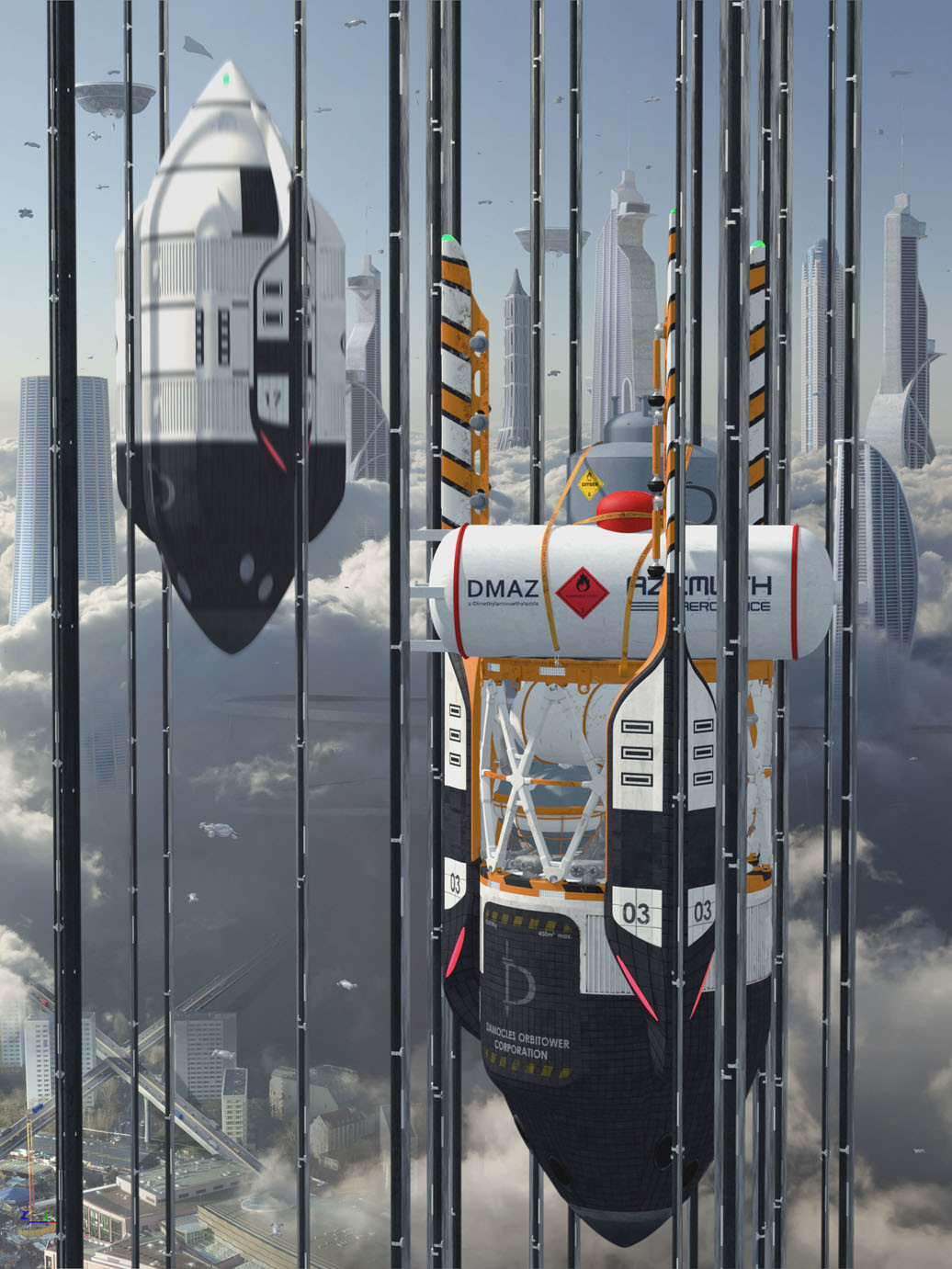
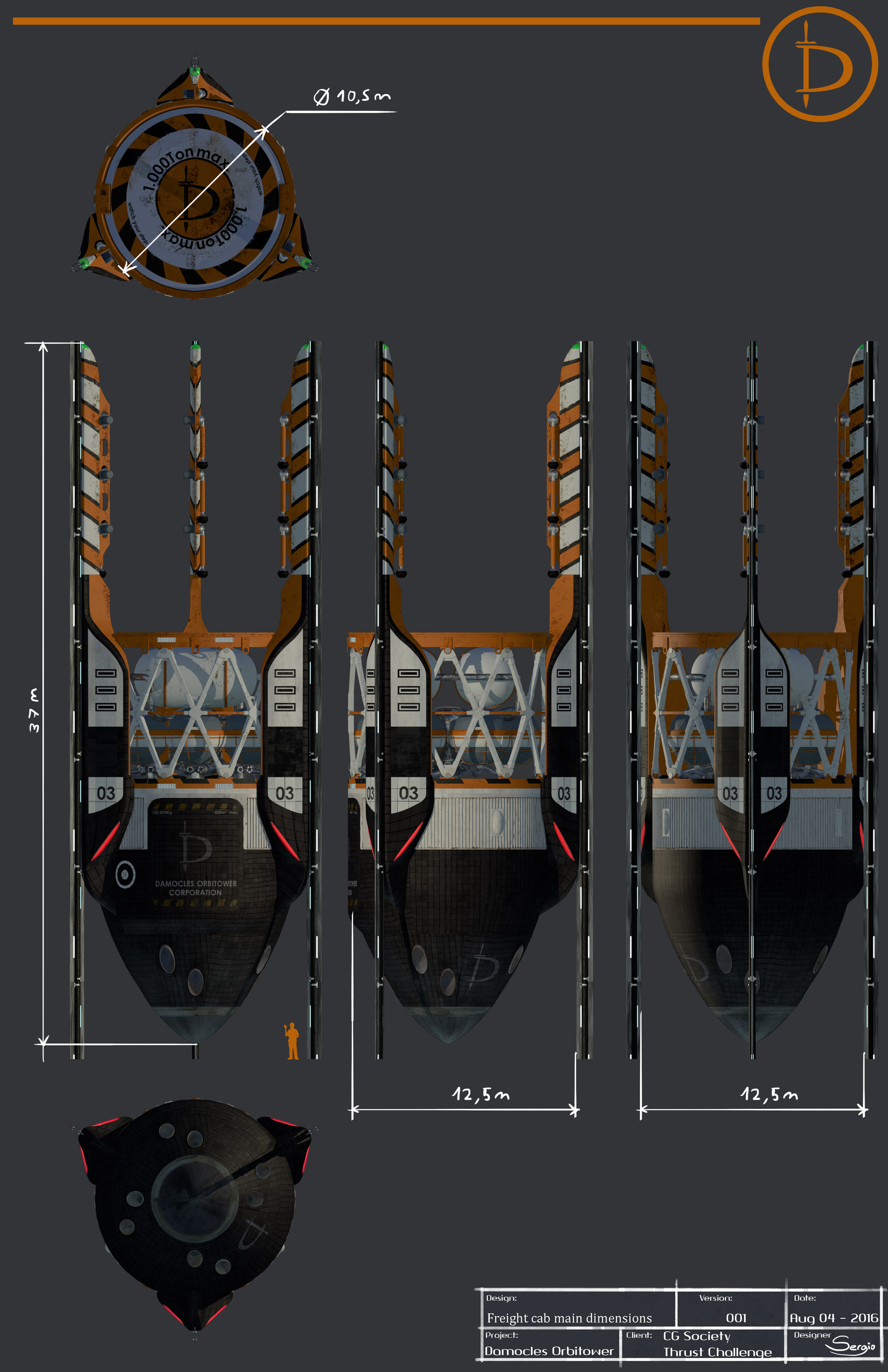
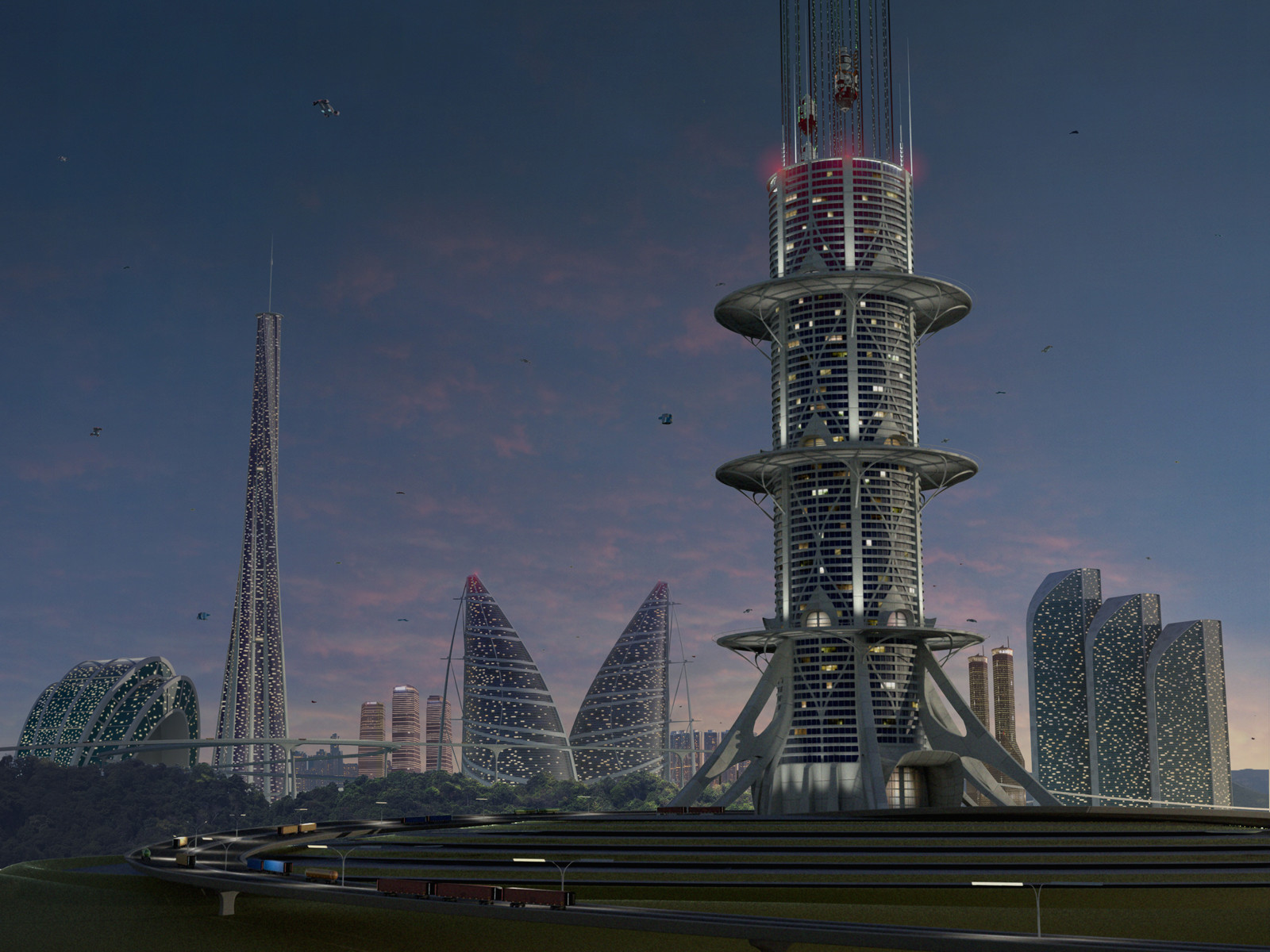
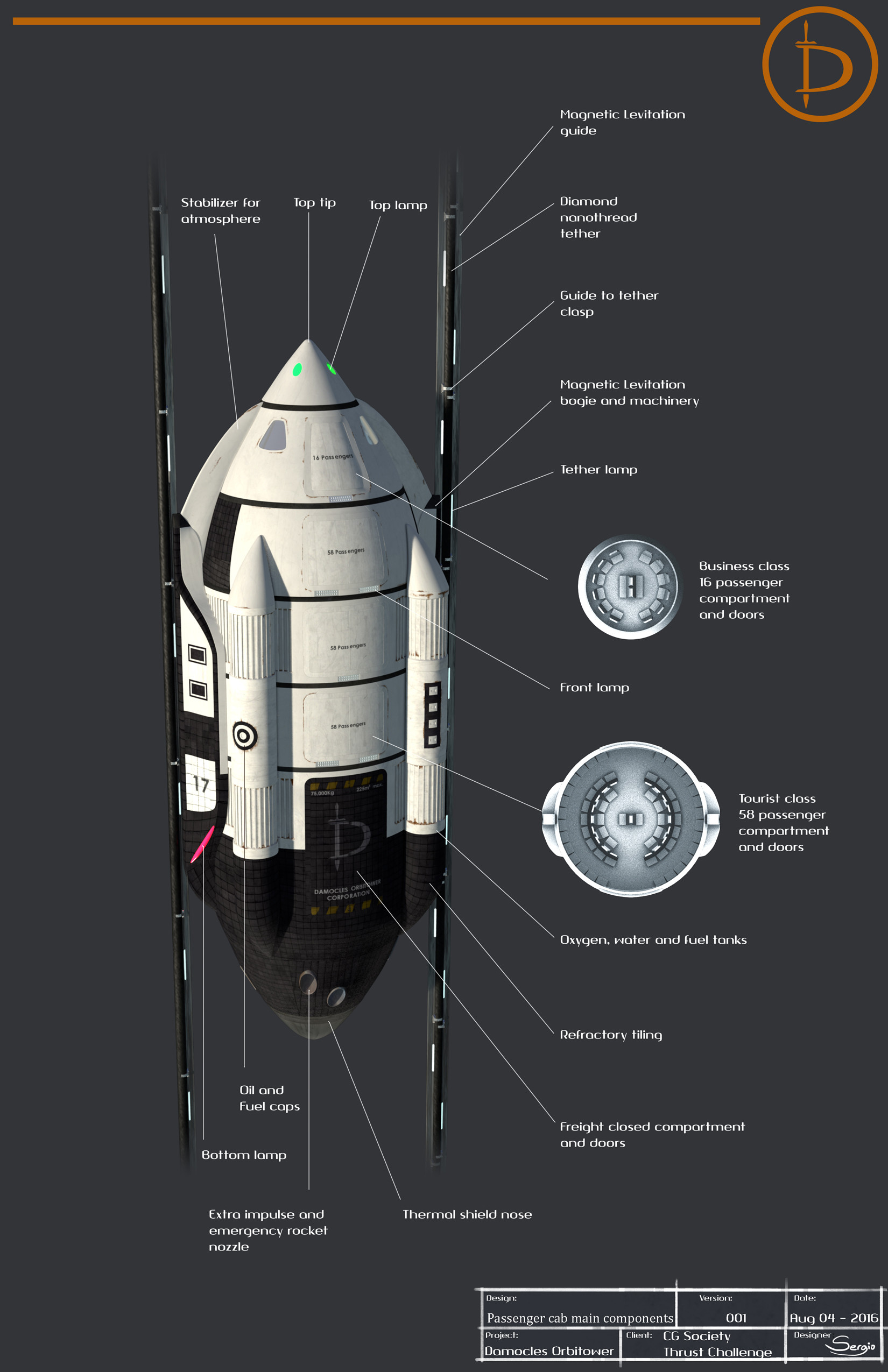
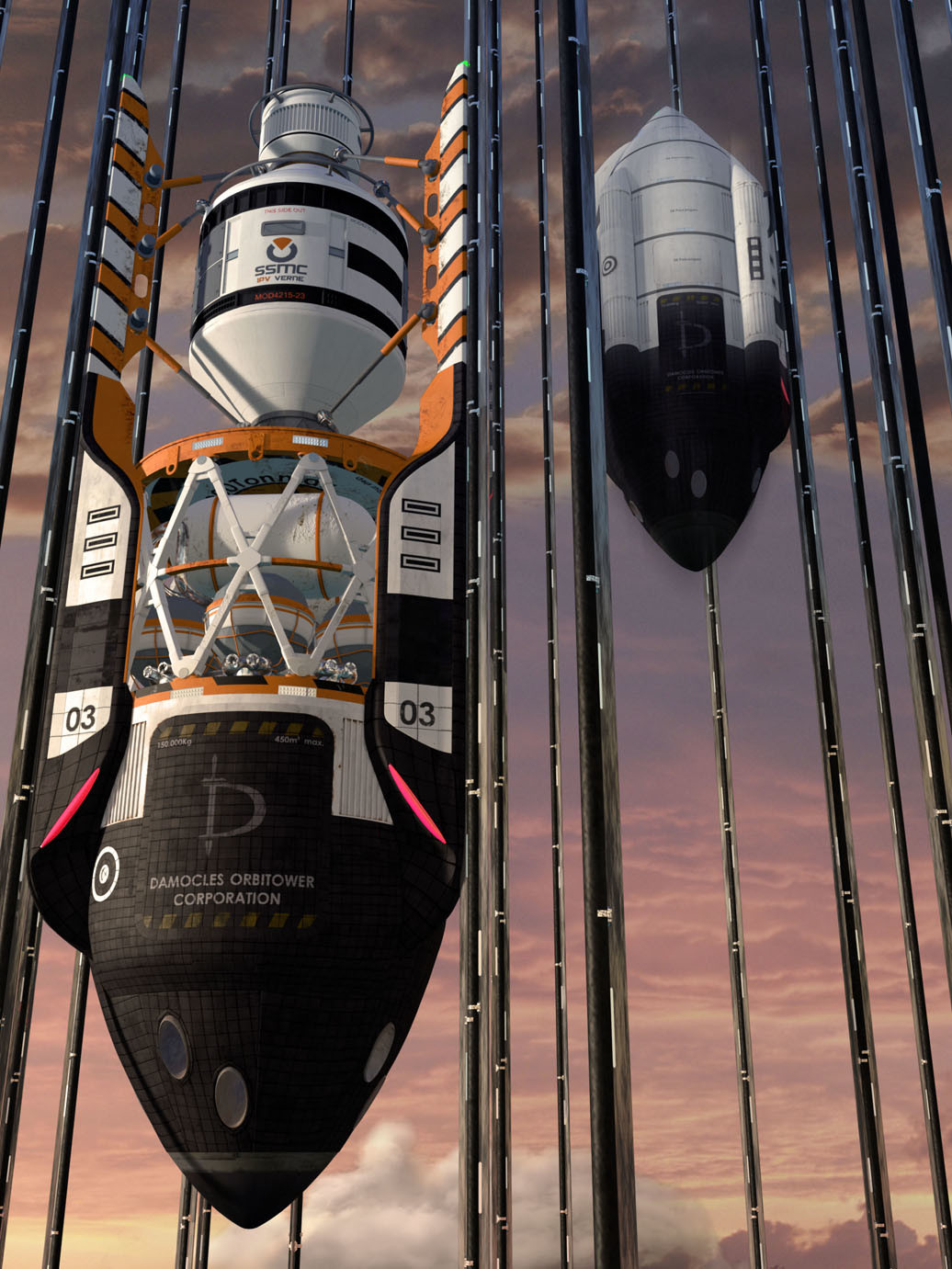
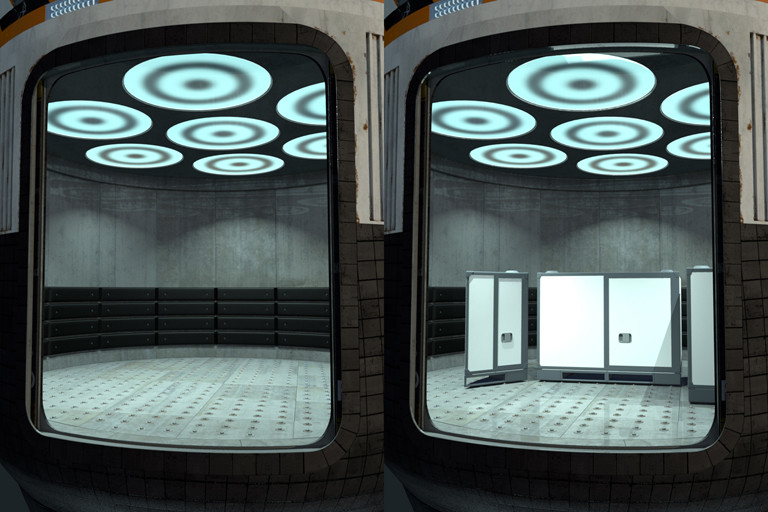
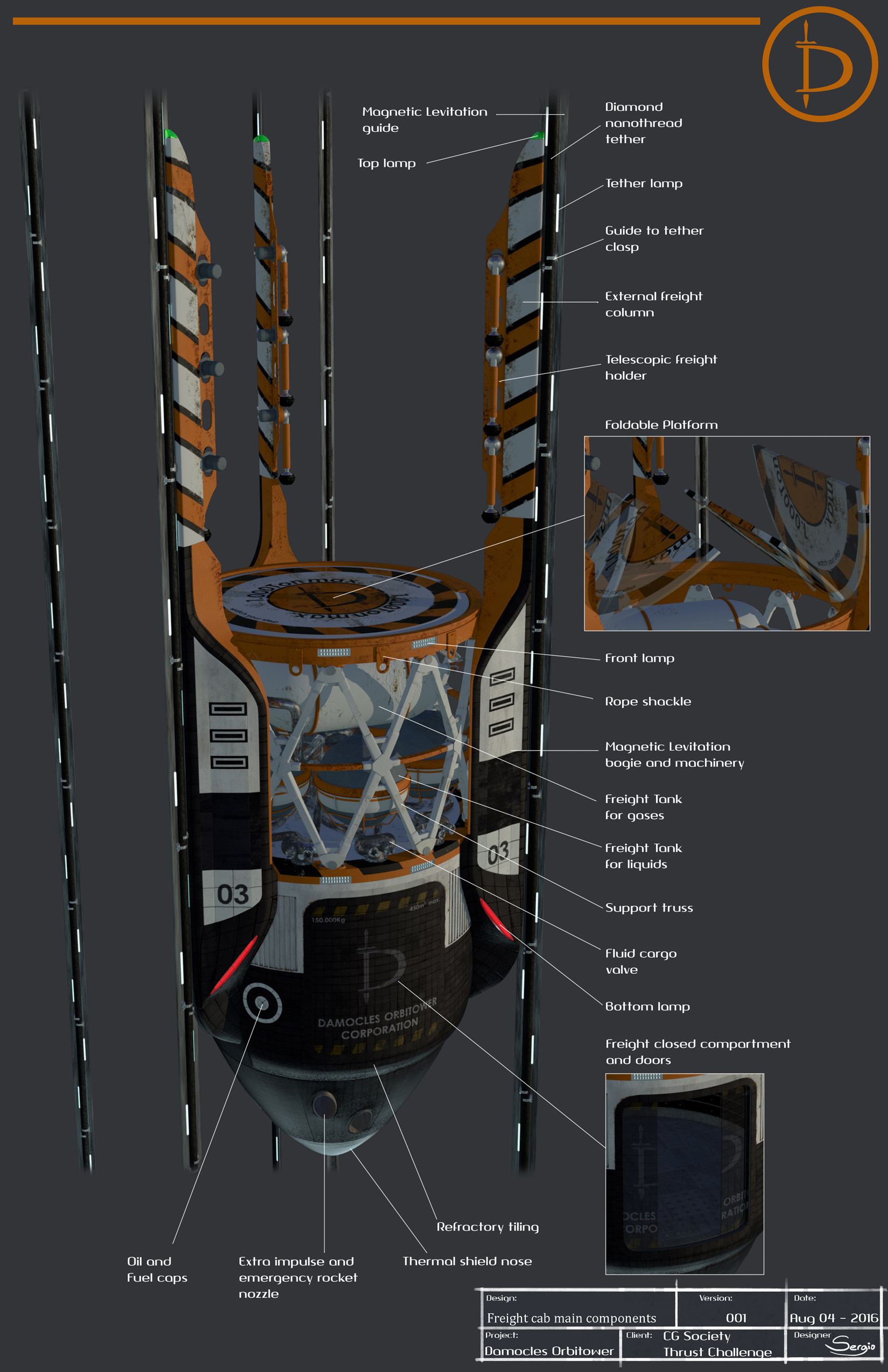
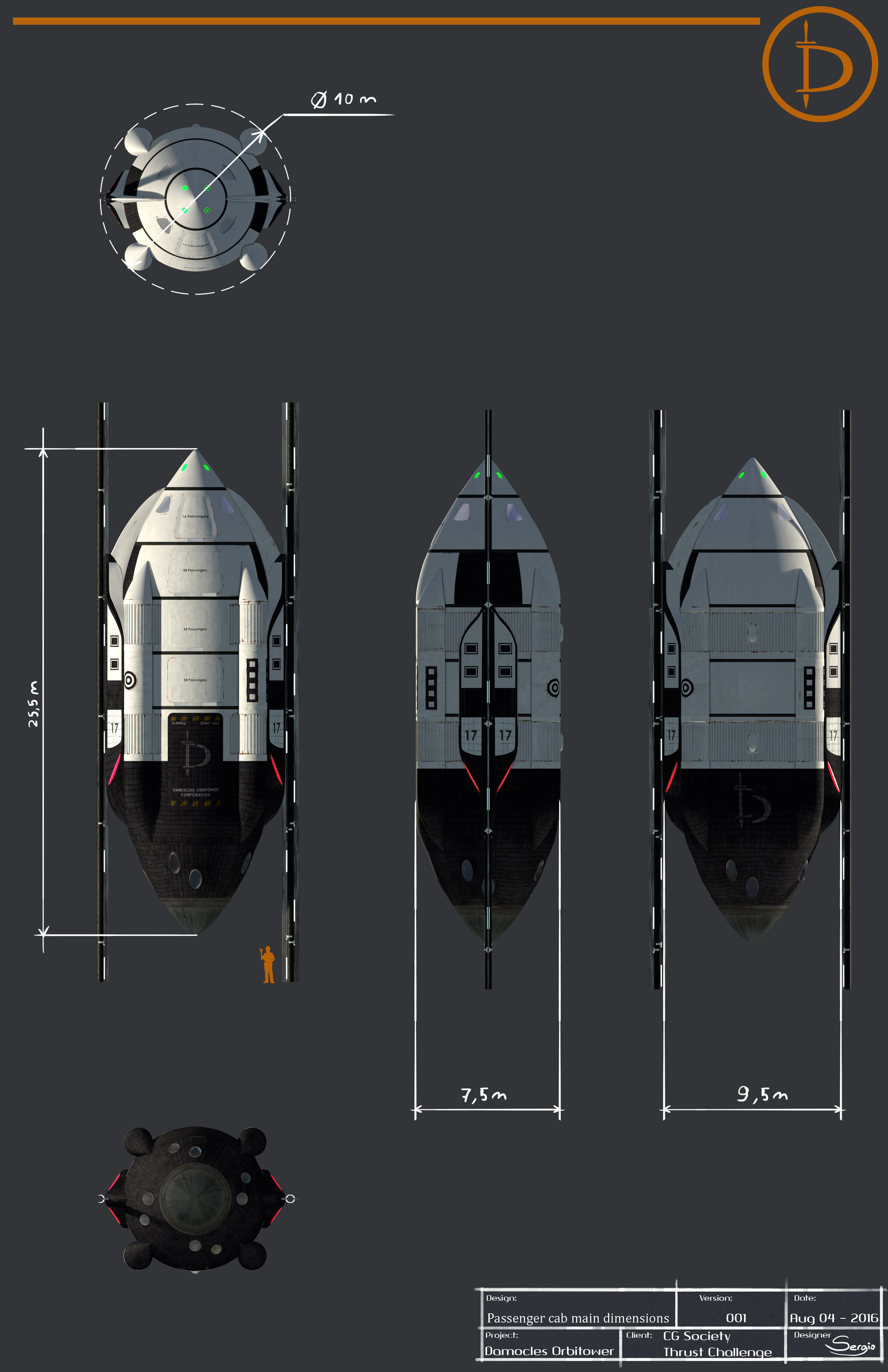
“The construction process consists of deploying the cable and constructing the facilities. It is necessary to analyze the cable dynamics in order to estimate the characteristics of the cable, counter-weight, facilities and climbers, and in order to determine the construction procedures. Parameters for the cable dynamics include tension, displacement and elongation of the cable due to ascending climbers, masses of counter-weight and cable, wind, and fixed loads of facilities. With the help of a computer simulation of the equations of motion, we designed the system and determined the construction process.\(^{[3]}\)
”
The tether would need to be tapered (meaning that the bottom and top portion of the tether have different thicknesses) and made out of an ultra-strong supermaterial like graphene. If you tried to make a space elevator using materials which are too weak such as steal, titanium, or diamond, the tether would snap and swing around the Earth's circumference. We would attach an elevator cab to the tether which could climb from the tether's base (at Earth's surface) all the way up to space in geostationary orbit. A space elevator would have an enormous number of uses, the most important of which being that it would provide us with a cheap way of transporting cargo and people from Earth's surface to the portion of space just above Earth. This would cause a dramatic boom in the space tourism industry since it would make going to space affordable for the average person.
When will this boom occur? We can be fairly certain that humanity will construct the first megastructure and the first cheap and reusable transportation system from Earth's surface to space sometime during this century (and, for those reading this in later centuries, I am referring to the 21st century). Indeed, the Japanese company Obayashi has announced its plan to build an Earth-based space elevator that will be fully operational by the year 2050.\(^{[3]}\) Some scientists and engineers have made rebukes about the feasibility of building an Earth-based space elevator. Some have argued that even a supermaterial like graphene would be insufficiently strong; but this problem could be solved by simply tapering the tether. The only major problem which exists that makes building an Earth-based space elevator impractical, today (not necessarily in the future), is that we have not yet developed a technique for manufacturing enormous quantities of graphene. We've been able to successfully manufacture a mere one inch of carbon nanotube comprised of pure graphene; we, unfortunately, are not yet able to produce tens of thousands of kilometers of the stuff, something which would be necessary in order to manufacture a space elevator tether. But, if we find a way to mass produce pure graphene, that would be a real game changer and building an Earth-based space elevator would become doable.
Space Tourism
"Since ancient times, people have always dreamed of going to space.
Only astronauts have been able to go until now, but progress has been made on efforts to enable even private citizens to experience space, and space travel is finally about to become an industry.
Shimizu foresaw the era of space travel early on, and has proposed a space hotel concept."\(^{[4]}\)
I'd like to spend some time elaborating on affordable space tourism because, in the future, it will be one of the primary economic motives for sending large amounts of people into space and creating the first space-based settlements. We have good reasons to expect that space tourism will "take off" in the first half of the 21st century and perhaps as early as the 2020s. The space tourism industry began on April 28, 2001 when the 60-year-old American businessman Dennis Tito became the first ever space tourist. He reportedly spent $20 million dollars to spend 8 days in space. Most of that time was spent on the International Space Station (ISS). There have only been six other space tourists since then. The last one, Cirque Du Soleil co-founder Guy Laliberte, flew to the ISS in 2009. As of 2018, numerous companies are working to make space tourism cheaper and to expand the industry. In early April of 2018, Orion Span announced its plans for the Aurora Station, the world's first space hotel.
The company plans on building Aurora Station in 2021. The hotel will feature two private suites which could accommodate up to four guests and two crew members per stay. The illustration above depicts what the interior of Aurora Station might look like. It would cost guests $9.5 million dollars per person for a 12-day stay; but the main reason why it will be so expensive is because of ultra-high launch costs. But with a space elevator, things would be much different. The space hotels depicted in the video and images below could be attached to the space elevator. The cost of visiting such a hotel would drop into the thousands and would be affordable by the average person.
The video above explains the concept of the Aurora space hotel.\(^{[5]}\)
Interior of a Space Hotel
Guest Room Module
"A module with 104 individual rooms, including 64 guest rooms, would be arranged on a ring that is 140 meters in diameter. The ring would generate an artificial gravity field of 0.7 G by rotating around three times per minute, so people could relax almost in the same manner as on earth."\(^{[4]}\)
Public Area
"The public area would be assembled into a complex structure in the form of a truncated octahedron. It would have a great room consisting of a lobby, restaurant, entertainment room, and other spaces where people could enjoy a dining experience, sports, and a variety of amusements under low-gravity conditions."\(^{[4}\)
Getting to Space Cheaply
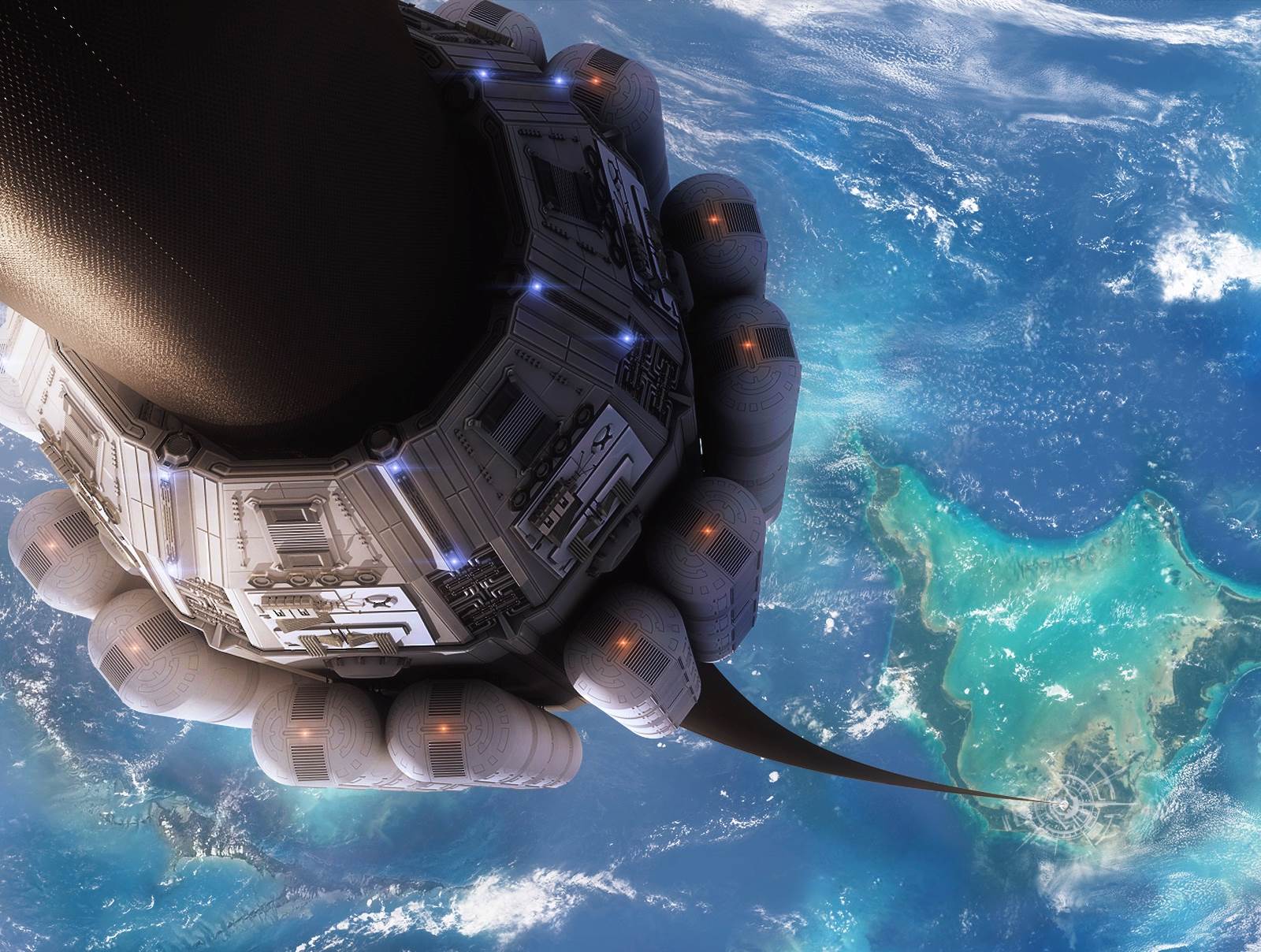
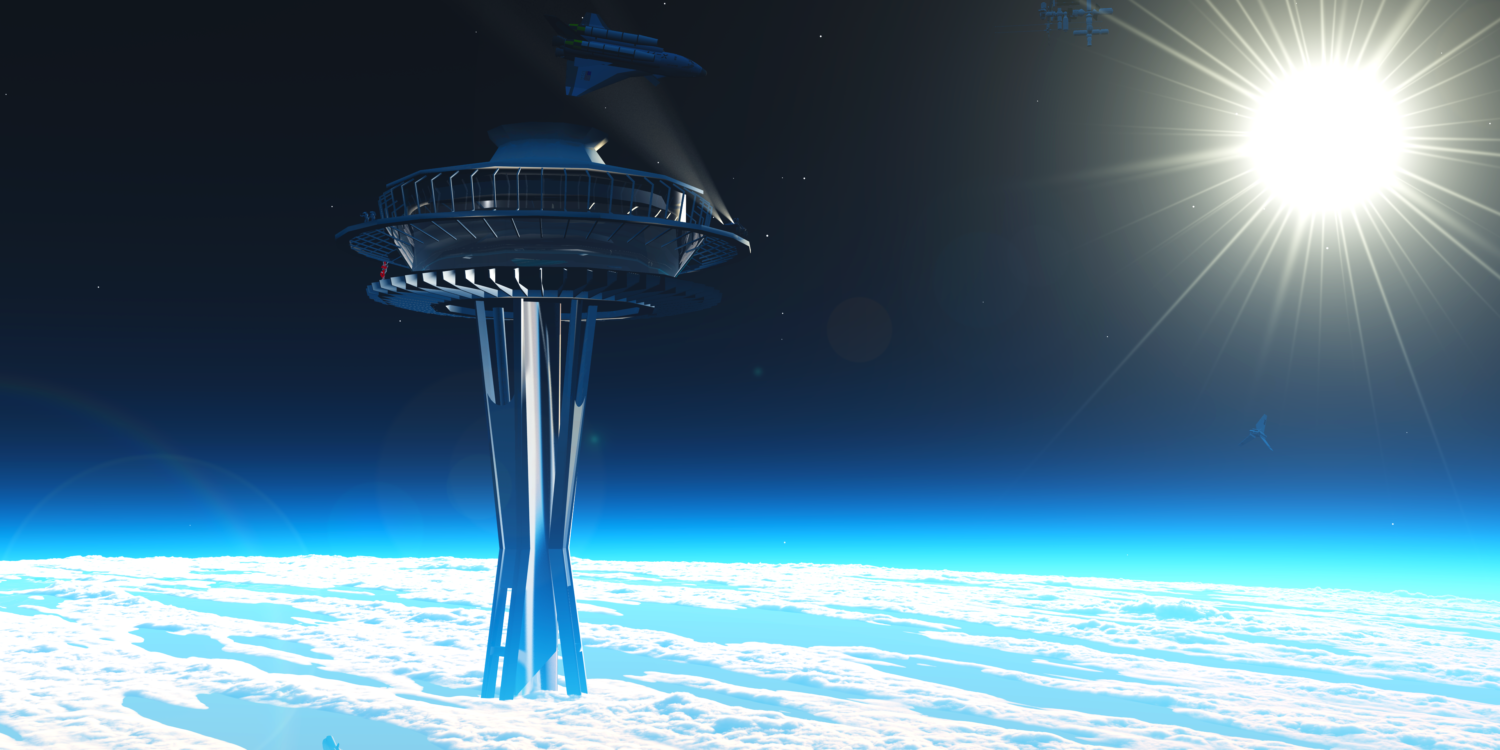
It is very clear that many companies see the economic potential in constructing space hotels and some kind of cheap and reusable transportation system which takes you from the Earth's surface to Earth-orbit in space.
It is my opinion that a space elevator might be the first such transportation system that we build; others, like Obayashi, would disagree and rebuke by saying that a space elevator will certainly be the first such transportation system that we build. Now, there are other options such as the orbital ring (which is, in all respects, superior to the space elevator), the launch loop, a star tram, or an Atlas tower. Even if it does in fact turn out to be the case that the space elevator is built first, we'll explain in this article why an orbital ring would be better. An orbital ring, which we'll describe in more detail later on, is just a giant ring that would surround the Earth (more generally, it can surround any massive body). That ring would be attached to the Earth by space elevators. So, even if we build the superior orbital ring or if we don't build one, the space elevator would still be used to get you and cargo to space. A space elevator would decrease the cost of sending things to space so much that, for the first time in human history, thousands and eventually millions of people would be able to visit space. This would be a revolution. It would mark the begining of a new epoch in human history—but I'll elaborate more on what I mean by that later.
We wouldn't merely just want to visit space, but we'd eventually want to settle space by building space-based cities and infrastructures. As of this writing, most private and government space industries want to either build permanent homesteads and human settlements on the Moon or Mars. This might eventually happen, but it would come with enormous difficulties. The first humans to live on the Moon or Mars would need to live in underground buildings or in settlements covered by either lunar or Martian regolith in order to shield human inhabitants from radiation. But, eventually, what we could do is build domed cities on these worlds (or underground cities which Elon Musk would like to create on Mars); such cities could indeed accommodate millions of people and shield them from radiation coming from the Sun and space. But there would be many additional issues which would come with living on a "world." In the case of the Moon and Mars, these worlds have one-sixth and one-third the gravity of Earth, respectively; this means that you'd weigh a mere one-sixth or one-third what you would weigh on the Earth depending on which of these worlds you were living on. We now know that even if you could live on the Moon and be protected from radiation, you'd still experience muscle atrophy and bone loss due to the ultra-low gravity. As for living on Mars, we're not yet quite sure what the long-term negative health effects would be from living on a world with only one-third the gravity as that of the Earth's.
O'Neil Cylinders and Space Colonies
“Far larger than any conventional Space Station, O'Neill Cylinders could potentially serve as entire city-states or nature preserves. Today we will review how these megastructures might be built and how they may represent a superior option to terraforming planets.”\(^{[8]}\) This video was produced by Isaac Arthur.\(^{[8]}\)
"The High Frontier: Human Colonies in Space is a 1976 book by Gerard K. O'Neill. It envisions large manned habitats in the Earth-Moon system, especially near stable Lagrangian points. Three designs are proposed: Island one (a modified Bernal sphere), Island two (a Stanford torus), and Island 3, two O'Neill cylinders. These would be constructed using raw materials from the lunar surface launched into space using a mass driver and from near-Earth asteroids. The habitats were to spin for simulated gravity and be illuminated and powered by the sun. Solar power satellites were proposed as a possible industry to support the habitats. The book won the 1977 Phi Beta Kappa Award in Science."\(^{[9]}\)
One day, the physicist Gerard K. O'Neil was lecturing a classroom of students about physics. The students in the classroom were disengaged and didn't understand what the point was to what they were learning. O'Neil decided to see if he could get his students to solve real world problems using the physics and problem solving skills he taught them. He posed to his students the following question: Is a planetary surface the best location for an expanding technological civilization? O'Neil even admitted that he did not expect much from this. But, nonetheless, some students from his Freshman classroom went to the library, did some research, and—to his surprise—actually came to the conclusion that a planetary surface was not the best environment and that an artificial space habitat would be superior. The students argued that if you somehow made a giant cylinder in space, if you rotated that cylinder it would generate artificial gravity on the interior surface of the cylinder. They determined that if the cylinder was large enough—which is to say, several miles long and several miles wide—it could retain and atmosphere. They speculated that land, seas, and cities could be built along the interiors of these rotating cylindrical habitats for humans to live in.
For the next several years, O'Neil expanded on their ideas and came up with the idea of an O'Neil cylinder. An O'Neil Cylinder is essentially just a "space city" that is a pair of two gigantic, rotating cylinders that are 20 miles long and 5 miles wide that humans could comfortably live in. The interior of an O'Neil cylinder would be homely incorporating, as O'Neil once envisioned, lovely river streams and lush forests; its own hydrologic cycle consisting of weather, an atmosphere, and even rainfall; an expansive city covering 500 square miles and homing a population of several million residents; and even its own day/night cycle. Both of the cylinders would rotate at a specific angular speed which would generate centrifugal forces everywhere along the interior surface which would pull everything down towards the surface simulating artificial gravity and each cylinder would rotate in the opposite direction in order to eliminate precession.
![O'Neill cylinders \(^{[10]}\)](https://images.squarespace-cdn.com/content/v1/58757ed7f5e231cc32494a1b/1535328647254-XM7IGVPM5Q5FSFJVBRDT/Spacecolony1.jpg)
![Interior of an O'Neill cylinder\(^{[10]}\)](https://images.squarespace-cdn.com/content/v1/58757ed7f5e231cc32494a1b/1535328642045-4HQ8UC0P24FKUQYP0AMC/Spacecolony4.jpg)
![Solar eclipse inside an O'Neill cylinder\(^{[10]}\)](https://images.squarespace-cdn.com/content/v1/58757ed7f5e231cc32494a1b/1535328643747-GNH72329EYBH31QMVX96/Internal_view_of_the_O%27Neill_cylinder.jpg)
![Interior of an O'Neill cylinder\(^{[10]}\)](https://images.squarespace-cdn.com/content/v1/58757ed7f5e231cc32494a1b/1535328686391-5SK58QHKS9AWR1JJLIIH/Spacecolony3edit.jpg)
The cylindrical surface would have three strips of land for biospheres and people and three windows. The three large mirrors surrounding the cylinder would reflect light onto that cylinder. As the cylinder rotates, the mirror would bounce light through a window and a strip of land on the opposite side of the window for roughly 12 hours. As the cylinder rotates, for the next 12 hours (roughly) that strip of land would no longer get light since light bouncing off the mirror is no longer passing through a mirror opposite to that strip of land. After that, the cylinder rotates some more and the land strip gets an additional roughly 12 hours of lighting. The net effect is to simulate the Earth's day night cycle. Each of those really small cylinders bunched together in a circle that you see in the image below are the agricultural belts which are used for food production. O'Neil was a visionary thinker and futurist. He imagined a zero-gravity habitat module located inside of the O'Neil cylinder which would be located on each cylinders spin axis. He imagined humans strapping on pairs of wings and flying like birds inside of such modules. He also speculated on the possibility of sports and recreational centers in zero-gravity and low-gravity zones.
Artist's depiction of a Model 3 O'Neil cylinder which would be capable of supporting millions of a people, a complete biosphere, and all of the Earth's natural habitats. An O'Neil cylinder could also be used as an arc ship (sometimes also called a generation ship) to travel to other stars or galaxies. Image by Glenn Clovis from Artstation.\(^{[11]}\)
O'Neil wanted to outfit his O'Neil cylinders with solar panels and build his "space cities" at either the L3 or L4 Lagrange points in the Earth-Moon system. In these locations, the O'Neil cylinders would remain stationary with respect to both the Moon and the Earth with the use of hardly any fuel to maintain their positions. He imagined converting the space-based solar energy collected by those space panels into microwaves and beaming it back to Earth where it would be collected by rectennas and converted into electricity to power the terrestrial infrastructure of the Earth. By doing this, O'Neil imagined that building these "islands in space" could be profitable and there, therefore, they would eventually be built. This would lead to a critical branch point in human history where, as both the researchers Gerard O'Neil and Paul Birch long ago recognized, there would eventually be more people living in artificial space habitats than on "worlds" like the Earth, the Moon, or Mars. And that fact implies another use of the O'Neil Cylinder: to alleviate overpopulation. We have created an entire civilization which is dependent on the oil and fossil fuels which took hundreds of millions of years to create and which are rapidly depleting. Our population will continue to increase but the fossil fuels which we need to produce energy and food for consumption will continue to be depleted. This is why despite the fact that we humans will merely visit space in large quantities first, we will eventually want to settle space and to create permanent human settlements throughout the solar system.
Having a very large population is only a problem if we do not have the energy, the space, and the resources to support that population. But, as we shall learn in greater detail later on, a civilization which spans the solar systems would have enough energy and resources to support trillions of people and likely even more. I would assert that provided we have the life support necessary to support all those people (which we would have plenty of in space), then a population numbering in the trillions and quadrillions is something that we would actually want. Having such an astronomically large population is something that gets discussed a lot on the SFIA YouTube channel. The reason why is because there would be so many benefits to having a far bigger population: it would allow us to create infrastructure and to manufacture spacecraft more quickly and it would cause our scientific and technological progress to accelerate at a faster rate too just to name a few.
An O'Neil cylinder, depending on whether we use a Model 1, 2, or 3, could house anywhere from 10,000 people up to several million. These O'Neil cylinders would have countless other uses besides merely offering more living space and more energy for earthlings. An O'Neil cylinder could also be used as what is called a generation ship, which is also sometimes called an arc ship. An O'Neil cylinder could be used for long interstellar voyages to distant star systems in the Milky Way galaxy. And, as the name "generation ship" suggests, an O'Neil cylinder would be useful for ultra-long trips which last for centuries and millennia; in other words, those voyages across space would last so long that the trip to the final destination couldn't be completed in a single human lifetime. Generations of people would live and die on these ships. And, as the name "arc ship" implies (which is just another name for it), these ships could contain entire ecosystems and biospheres of living creatures. This is because the interior of the O'Neil cylinder would replicate real habitats which we see on Earth including rain forests, jungles, oceans, deserts, rivers, ponds, and so on. You could think of an O'Neil cylinder as a scaled up version of Biosphere 2. The notion of transporting ecologies and ecosystems from the Earth to distant Earth-like alien worlds in other star systems is something which will be discussed in greater detail in future SFIA episodes and articles on Greg School.
It really wouldn't take all that long to build the first O'Neil cylinder. Such a megastructure will perhaps be built sometime during the 2100s given the current trends in populations growth and the depletion of our resources and environment, all of which will, incidentally, be our primary reason for building permanent space-based settlements for humans to live in. There initial use will be primarily as additional living space for us and for providing microwave power to the Earth, satellites, and spacecraft. The researcher Paul Birch estimated that, by the year 3000 AD, humanity will have colonized the entire solar system by using traditionally proposed methods of colonizing and terraforming Mars, Venus, and the celestial bodies in the asteroid belts and the Oort cloud and that also our descendants would employ a slightly more novel and efficient approach to colonizing worlds by building great big spheres around the Jovian planets and the Sun. This prediction was made in a paper in the 1980s but we've made such tremendous progress since then that this will likely be an underestimate—we will probably colonize our Solar System much sooner. The methods and techniques which our descendants use to colonize the solar system are, uncertain.
I personally believe that such beings will have overcome scarcity and, like the 24th-century society in the SiFi TV show Star Trek, will have invented an entirely new system of economics, one which is not based on money or markets. Their decision-making apparatus and the way in which they arrive at decisions will be determined by that which maximizes industrial efficiency, and which maximized the health of their species and their biosphere at large. But what, you might ask, is the most efficient way to colonize the solar system? The answer is most likely by building successively larger supramundane planets and shell worlds, which we'll elaborate upon in greater detail in a little bit. These are not "real" planets like those which were formed naturally during the formation of our solar system. They are, in fact, artificial planets that we can build using resources from the Sun and other worlds. The first supramundane planets and shell worlds would surround and englobe the Jovian planets Jupiter, Saturn, Uranus, and Neptune. Eventually, by the year 3000 AD (or much sooner), they could perhaps build a Dyson sphere around the Sun which could be used for energy extraction and as a human settlement.
The first major branching point in the future starts with humans building a cheap and reusable Earth-to-space transportation system.
Final Frontier Voyager (2007), George Grie. Óleo sobre lienzo.\(^{[13]}\)Credit: https://commons.wikimedia.org/wiki/File:Final-Frontier.jpg
Indeed, I said earlier that this would be a revolution and mark a new epoch in human history. And the reason why I said this is because it would represent the first time in our species history when vast migrations of peoples left the Earth to find refuge in new lands—likely involuntarily, and due to catastrophes and seeking refuge in new safer lands as most human migrations of the past in our species history were. For our ancestors, those new lands were separated by the vastness and enormity of the continents and the oceans. Indeed, in ancient Greece and Rome they imagined a vast and encompassing world frontier spanning the seas. To them, the sea seemed an impenetrable mystery, an insurmountable frontier. But it is the spirit of wanting to explore and see what else is out there which inspires people to voyage to undiscovered lands and new worlds. This is to say that many of the great human migrations of past epochs were purely on a whim and initiated for no other reason than because we were curious. This was indeed the primary motive of all those ship-sailing voyages of Columbus and Magellan. Another reason is purely economic: by voyaging to new places, we oftentimes find a wealth of new materials and riches which can be used for our own benefit and to improve the general prosperity and wellbeing of our society.
But a third reason, which also happens to be the most dire, is purely out of survival and avoiding getting wiped out. Over a hundred thousand years ago, our species almost went extinct: if it was not for our decision to leave Africa, we certainly would have not made it like, incidentally, 98% of all other species of life throughout the history of this planet. I imagine that we humans will go to space for all three reasons, though escaping self-destruction will certainly be the most pertinent reason. In history, we oftentimes demarcate new epochs based on these migrations to new places. Indeed, this trend will continue into the future and future historians will recognize humanities expansion into space as the beginning of a new epoch. For our ancestors, those new lands were separated by the vastness of the continents and the oceans; but for future generations, the new places that they go to will be separated by the vastness of space. Like their ancestors who did not fear long voyages across unfamiliar seas, they will in locution of the astronomer Johannes Kepler’s Somnium, build large vessels adapted to the breezes of heaven who will not fear the vastness of space.
Building that first megastructure that will allow us to get to space cheaply, whether it be a space elevator or orbital ring or something else, will represent the beginning of humanity’s colonization of the Solar System. This will be the discussion of the article you are reading right now. The next revolution, which would also be demarcated by a vast human migration, would start with the beginning of star lifting. The beginning of star lifting would lead to an agricultural and industrial revolution far more dramatic than anything we have ever seen before in human history. This is because, for the first time, we'd have access to all of the materials comprising the Sun. The Sun, which contains roughly 99.8% of all that material in our solar system, has so many resources and so much energy that it would allow us to support a population far in excess of the quadrillions. It would allow us to manufacture billions of generation ships which would set sail for the stars and the galaxies. But all of that will be saved for the discussion in the next article.
Star Lifting
Images above is an artist's impression of a star lifter.\(^{[14]}\) Artwork by Neil Blevins at Artstation.\(^{[14]}\)
"Arthur C. Clarke’s 3001: The Final Odyssey features an orbital ring held aloft by four enormous inhabitable towers (assumed successors to space elevators) at the Equator."\(^{[15]}\) For book summary, see: https://en.wikipedia.org/wiki/3001:_The_Final_Odyssey
If we assume that the chemical composition of the Sun is more or less identical to that of the whole Cosmos comprising 63% hydrogen, 36% helium, and 1.4% other elements in the periodic table, then after 300 million years of Sun lifting \(4.8×10^{24}\) tons of new water could be manufactured using hydrogen atoms scooped from the Sun and oxygen atoms imported from rocky planets, moons, and asteroids residing in the inner-solar system. This amount of water would be sufficient to create active hydrospheres within O'Neil cylinders, or ring worlds, or artificial planets, or terraformed worlds within our solar system such as planets, moons, and asteroids. That 1.4% of "other stuff" are the atomic elements which would be used to manufacture materials such as metals, oxides and plastics. These are the materials which we'd use to build new megastructures besides the pre-existing star lifter. Now 1.4% might not sound like much - but actually it is! The 1.4% of elements comprising the Sun besides hydrogen and helium has a total mass on the order of \(10^{24}\) kilograms. That is the equivalent of about an Earth's worth of stuff! Let's assume that for every square meter we used 10 tons of those materials to build stuff like space homes. Then, for each year of Sun lifting, we could build 1 billion square kilometers of new living area. This process could continue for 300 million years until the end of Sun lifting. After 300 million years of Sun lifting, we could have built an astonishing \(5.7×10^{17}\) square kilometers of new living area. That is the equivalent to the total surface areas of a billion Earths. Perhaps a mere few million people could inhabit close to one billion worlds each. Thus, roughly 300 million years from now, what humanity calls home will have become a much bigger place.\(^{[16]}\)
But with all of those new space homes (which could include O'Neil cylinders and other kinds of arc ships), we certainly wouldn't stay confined to the miniscule realm of this solar system; but rather, we would want to use such space homes and arc ships to expand across the Milky Way galaxy and beyond in a mass exodus fleet. Indeed, this expansion wouldn't stop at the galactic edge of the Milky Way; these arc ships would eventually reach other galaxies. The first other galaxies we'd reach would be the nearby satellite galaxies and we'd colonize other galaxies out to a distance of perhaps a billion light years away from us. We shall discuss the interstellar and intergalactic journies of these arc ships below. That discussion of how star lifting would represent the begining of humanities expansion across the stars and galaxies using gargantuan arc ships is a discussion which I have saved for the article below entitled, Migrating Away from the Solar System. I consider that article to be a sequel to the one you are reading right now; whereas this article concerns how humanity might colonize the solar system using megastructures and other technology, that second article discusses how humanity would migrate beyond the solar system to colonize other star systems, eventually the Milky Way galaxy, and after that other galaxies, and perhaps, if it is even possible, they would then go on to colonize portions of the multiverse. We save discussing the latter for the next article.
The heart of this article is really that a type of megastructure called an orbital ring is what will allow us to cheaply leave this pale blue dot called Earth and go into space. So, orbital rings are the keystone and heart of this article. And, once that first orbital ring is built and we can get into space for a fairly modest cost that would be comparable to that of a plane ticket, the demand for people and cargo to go to space would increase enormously. That would cause quite the boom in the space industry. Accordingly, we would need to build space hotels much larger than Aurora: we'd want to use megastructures like the Standford Torus or Bernal Sphere, which are capable of accommodating up to 10,000 people, as space hotels. But, eventually, we'd have so many people using these orbital rings to go to space that it would eventually make sense for people to permanently live up there. Because of that, we'd want to build things like the aforementioned O'Neil cylinders. Now, for a civilization like we who are, to borrow Carl Sagan's wording, only ankle deep in this vast cosmic ocean, we're not quite ready for star lifting yet and so, those first O'Neil cylinders would actually be built using materials from the Moon.
Indeed, as we mentioned, O'Neil's original plan was to build those first O'Neil cylinders using materials from the Moon. This is precisely why he wanted to build a lunar mass driver: to hurl lunar material into space which would be used to build O'Neil cylinders. I recently added some additional writing to the article, Colonizing and Industrializing the Moon, which gives a more in depth explanation of how the mass driver would launch materials from the Moon to space where that material could subsequently be used to build O'Neil cylinders. As we go through this article, it will eventually become clear that orbital rings are the key to also colonizing the Jovian planets and the Sun because they allow you to build things like artificial planets, Dyson spheres, and Matrioshka brains. Thus, we'll try our best to wrap up this article by discussing, at least partially, how we humans will colonize this entire solar system. After that, in the next article, we discuss the commencement of star lifting and leaving this solar system.
Orbital Rings: the Wholly Grail of Megastructures
“The Orbital Ring is a type of launch-assist system that goes beyond moving small ships and crews into space and allows cheap movement of bulk cargo up to space, into orbit, and beyond.”\(^{[17]}\) This video was produced by Isaac Arthur.
We've discussed how one company plans on building the first space hotel by 2021. That hotel will be designed to be able to accommodate only 4 guests. This is because the cost of a one week stay at the aurora space hotel is a staggering $9.5 million dollars and, at a price that high, you won't be getting all that many space tourists and, thus, there isn't really much need to build a hotel much bigger. Indeed, with current launch costs so high, we really don't send up all that much cargo into space either. And, as we've previously mentioned, the reason why it is so expensive to go to space is because, to get to space, you must use a big bulky rocket that consumes a mind blowing amount of fuel; all of that fuel and all of that material used to make the giant rocket is quite expensive.
Animation of a sheet of pure graphene rolled up into a carbon nanotube. Credit: https://commons.wikimedia.org/wiki/File:Kohlenstoffnanoroehre_Animation.gif
Indeed, it is astronomically expensive. If we could build a space elevator, then the cost that a person would have to fork over to go to space using the space elevator would be comparable to an airplane ticket. But the problem with space elevators is that we're not sure that even supermaterials like graphene would be strong enough to get the job done.
What's worse is that even if the material was strong enough, we don't yet know how to mass produce the stuff in large quantities.
So does this mean that taking a vacation in space will forever be a privilege for only the mega-wealthy and something which will never be accessible to the average person? Fortunately, the answer is no and the reason why the answer is no is because of something called an orbital ring. At the most basic level, an orbital ring would just be a giant ring around our planet which would be connected to the Earth by tethers. What's nice about an orbital ring is that they could be built at an extremely low height of just above the height of mountains (and, indeed, even on the Earth's surface or underground), though it would be preferable to build the first orbital ring hundreds of kilometers above the Earth's surface.
"The inner and outer static orbital rings around Bronx are linked to a central geostationary ring by carbon nanotube cables. The inner ring is only 265km above the clouds, while the outer ring is 75,600km from the planet's core."\(^{[19]}\) Image from Steve Bowers.
How many kilometers above the Earth's surface should the first ring be? According to Paul Birch's first paper on orbital rings, we should build that first ring in Low Earth Orbit (LEO) at a height of either 300km or 600km. Once that orbital ring is built at LEO, we could then run tethers down from the orbital ring to the Earth's surface. And what's so nice about the fact that orbital rings can be built at a low altitude (relatively speaking) is that the tethers don't need to be as long (and, thus, they don't need to be quite as strong either) to reach space at LEO. Whereas building a tether for a space elevator would require that the tether be comprised of materials with a breaking length of tens of thousands of kilometers, the tethers attaching an orbital ring to the Earth's surface need only be comprised of materials with a breaking length of tens to hundreds of kilometers. If you built your orbital ring at a really low height, you could even get away with using materials like aluminum, stainless steel, or titanium to build those tethers out of. In reality, of course, you'd want to make the orbital ring higher off the ground at LEO; Paul Birch suggested in his first paper that at a height of 300km in LEO, the tethers could be comprised of Kevlar or glass fiber.
Artist's depiction of the interior of a Stanford torus. Painted by Donald E. Davis.
Paul Birch was a scientist, engineer, author, and astronomer who published a series of three papers on orbital rings (and, indeed, other topics like artificial planets which we'll cover later) in the Journal of the British Interplanetary Society in 1982.\(^{[20][21][22]}\) His work was the first rigorous and scientific treatment of orbital rings which demonstrated that building something like an orbital ring would have been possible all the way back in 1982. Once built, people could go to space by taking an elevator ride up a cable at a cost comparable to the cost of a plane ticket. This would cause a boom in the space tourism industry and, for the first time in our species histoy, you would (due to the comparitvely low Earth-to-space transportation costs) be getting thousands and eventually millions of people wanting to go to space. Of course, if the demand for space tourism is that high, then we'd need much larger space hotels than the Aurora space hotel. It would make economic sense to build something like a Standford Torus and use that as a space hotel. A Standford Torus is the donut shaped structure that you see surrounding the tether (which is attached to Earth and the orbital ring). A Standford Torus is a type of artificial space habitat which could support up to 10,00 people and which produces artificial, Earth-like gravity by spinning. As the demand for going to space steadily grows, we could accordingly make additional Standford Toruse's and orbital infrastructure. Of course, Standford Toruse's are not the only option on the table and we could also use megastructures like the Bernal Sphere or O'Neil cylinder as space hotels.
Cut-away view of the interior of a Standford Torus. Image courtesy of NASA Ames Research Center.
Image above portrays Nikola Tesla, the famous inventor who first conceived of the notion of orbital rings in the 1870s shortly after recovering from malaria.
In addition to orbital rings being great for the economy, they also have many other pertinent uses. For example, Paul Birch discussed building a system of three orbital rings around the Earth where one ring could act to combat global warming by shading portions of the Earth. A second ring could be used as a world wide communications system which would be superior to today's communication system which relies on the use of satellites in geosynchronous orbit around the Earth. The third ring would be used to transport cargo and people from Earth to space at ultra-low costs and, furthermore, vehicles could climb up the tethers at supersonic speeds and travel around the circumference of the ring at hypersonic speeds. Now that's fast and it would allow people to travel around the Earth at much greater speeds than the conventional airplane—and the price for a ticket would be about the same too. These vehicles would be maglev, meaning that this transportation system would also be super energy efficient. Now, it's interesting to note that the famous inventor and polymath Nikola Tesla was actually the first person to ever conceive of the notion of an orbital ring. He imagined the ring being used as a global transportation system all the way back in the 1870s as recounted in his autobiography My Inventions (1919):
Another one of my projects was to construct a ring around the equator which would, of course, float freely and could be arrested in its spinning motion by reactionary forces, thus enabling travel at a rate of about one thousand miles an hour, impracticable by rail. The reader will smile. The plan was difficult of execution, I will admit, but not nearly so bad as that of a well-known New York professor, who wanted to pump the air from the torrid to the temperate zones, entirely forgetful of the fact that the Lord had provided a gigantic machine for this very purpose. (Tesla & Johnston, 1919)\(^{[23]}\)
A tether running down from that orbital ring at LEO could be attached to an eucomonopolis or arcology on the Earth's surface; it would be desirable to build that tether out of an electrically conductive material (in the future, that material might be something like graphene); an array of space-based solar panels attached to the orbital ring could convert the energy of the Sun's photons into electrical energy which could be transmitted through the tether. Put more simply, solar power (collected from space) would get converted into electricity which gets sent down the tether and, subsequently, gets used to power an expansive megacity such as an eucomonopolis or arcology. Even using a modest material as a conductive tether, you could transmit that energy down to Earth's cities with very low power loss. We've talked about using space-based solar panels before to power the world; for example, the physicist Gerrard K. O'Neil imagined attaching them to space colonies and beaming them back to Earth whereas the physicist David Criswell wanted to build them on the Moon and beam it back to Earth.
But the problem with these methods is that you have to convert the electricity produced by the solar panels into microwaves, have those microwaves pass through the Earth's atmosphere, and finally those microwaves must be converted back into electricity using pretty expansive rectennas. That's an annoying problem because you're losing a lot of useful power during all three steps of that whole process. But what's so nice about attaching your space-based solar panels to an orbital ring is that once your solar panels convert the Sun's solar energy into electricity, all you need to do is send that electricity down the tethers and straight to your cities. You wouldn't lose nearly as much power this way and, if you built your tethers out of something like graphene, you'd lose almost no power at all. So, that's yet another extremely pertinent use of an orbital ring; you can use one to power all of the world's cities and infrastructure.
More on that global transportation system though, you could have numerous space elevator attached to a single orbital ring (or indeed multiple orbital rings) where each space elevator runs from a city up to the orbital ring. People could easily be transported from a city to the orbital ring; once they arrive at the orbital ring, using a meglev train they could be transported to another tether (and, hence, another space elevator) attached to a different city; lastly, once they arrive at another space elevator, they could descend in that space elevator's cab to that different city. Since an orbital ring or a system of multiple orbital rings could encircle the entire planet, such a system could function as an ultra efficient and ultra cheap global transportation system.
Indeed such a system would be far better—from a cost efficiency perspective (in that it would be cheaper) and from Buckminster Fuller's or Jacque Fresco's perspective on true economic efficiency (in that this system would involve less net energy expenditure, less material waste, etc.)—than Elon Musk's recently proposed method of global transportation involving the use of reusable, BFR rockets which transport people and cargo from one continent to another in under one hour. The problem with Elon Musk's system is that rockets use non-renewable fuel and release greenhouse gases into the atmosphere which contribute to global warming; but a planetary transportation system involving orbital rings, space tethers, and maglev trains could be powered, entirely, using space-based solar power and would not pollute our atmosphere with greenhouse gasses (indeed, those orbital rings would be used to combat global warming).
Artist's depiction of solar panels attached to a space elevator.
I'd like to also mention that there is nothing special about the Earth and you can build orbital rings around any planet, moon, star, or even black hole. We see one example of an off-Earth orbital ring in science fiction in the video game Warhammer 40,000 where Mars has a large orbital ring called the Ring of Steel surrounding it. The Ring of Steel is used, primarily, as a shipyard for interstellar spacecraft and it is the largest man made structure in the galaxy. Now, in reality, we can be completely certain that something like an orbital ring wouldn't even come close to being the largest structure built by a galactic empire as we'll discuss later. Furthermore, while it is conceivable that a space fairing civilization might use a Martian orbital ring to build interplanetary spacecraft, it would make a lot more sense to build interstellar spacecraft near the Sun using materials extracted via Sun lifting. That aside the reason why I raise this example from science fiction is because we could indeed build an orbital ring around Mars if we wanted to. This would actually be quite useful because landing rockets on Mars is pretty difficult with its thin atmosphere; but with an orbital ring, an incoming spacecraft could be captured using a sky hook.
Terraforming Venus
"Terraformed Venus is surrounded by a Dynamic Orbital Ring, mosty constructed from carbon extracted from its original atmosphere."\(^{[24]}\) Image by Steve Bowers.
We could also build an orbital ring on Venus even before the planet is fully terraformed. We discussed in a previous lesson, Colonzing and Terraforming Venus, that to terraform this world we'd want to use something like a giant sollete (which is basically just giant mirrors) to block the Sun's incoming light in order to cool that planet down. After a long enough time, all of that \(CO_2\) in the atmosphere will be converted from a gas into a liquid and rain onto the ground. A scientist named Martin Fogg described in the book, Terraforming: Engineering Planetary Environments, that every step involved in terraforming Venus is totally practical and doable except for one step and that is the one which involves getting rid of all that \(CO_2\) on Venuse's surface which would eventually freeze into ice. The amount of energy to do this would be truly extraordinary; that is, of course, unless you have orbital rings built around Venus. With orbital rings you can hang larger Atlas towers down from them which could be used to remove \(CO_2\) directly from Venus's atmosphere while it is still in its gaseous state. Doing that, without question, would ease the process of terraforming Venus.
Colonizing the Oceans
Orbital rings could also be potentially useful for colonizing the oceans. In a separate lesson we discuss the possibility of structures known as Ocean Spirals being built all around the Earth. These structures are enormous helical structures which would descend from the surface of the sea all the way down to the sea floor. On the top of the Ocean Spiral you would have cities right there on the surface of the sea and you'd also have cities underneath the sea floor. Those cities on the sea surface are essentially arcologies which could be connected to an orbital ring in LEO. We discuss this in greater detail in that other lesson, but essentially what you'd end up with is a single super structure that extends from space to the sea floor and you could easily transport cargo and people from one altitude to another. We also discussed the possibility of boring tunnels underneath the sea floor and using those tunnels for maglev transportation from one spiral to another. Indeed, this is very similar to what Elon Musk's Boring Company is doing; the only difference is that the tunnels would be built deeper down below the Earth's surface. This is where the concept of the orbital ring comes in.
Artist's conception of the Kepler Space Telescope.
As Paul Birch stated in his paper, you can build these things underground and you can build many of them underground if you want. These orbital rings could be used for maglev transportation which could transport people and cargo from one Ocean Spiral to any other Ocean Spiral in the world; or they could take you from an Ocean Spiral to an underground city, or vise versa. Unlike the orbital rings in LEO which would be powered either by using space-based solar power or nuclear fusion, we could power these underground orbital rings by tapping into the geothermal energy provided by the Earth's mantle. We could bore tunnels which extend from the underwater orbital ring to the Earth's mantle and attach a graphene cable to the orbital ring which stretches from that underwater orbital ring all the way to the Earth's mantle. Graphene is one of the worlds best thermal conductors and heat from the mantle would be transmitted to the other end of the cable almost instantly; after that occurs, the thermal energy could be converted into electricity and used to power the orbital ring. Colonizing oceans is, of course, not just restricted to this world. As we learned in the article, The Diversity of Exoplanets in the Galaxy, the Kepler Space Telescope has discovered many exotic exoplanets including what has become known as water worlds. Unlike the Earth, these worlds typically have no land and the entire surface is covered in water.
Artist's illustration of a hypothetical ocean planet with two natural satellites. Image credit: https://commons.wikimedia.org/wiki/File:Oceanplanet_lucianomendez.JPG
Water worlds are typically much larger and much more massive than our own. Paul Birch in his papers imagined the possibility of underground orbital rings. Indeed, underwater orbital rings would work too. We could build many underwater orbital rings which are oriented at equal angles with respect to the equator of a water world and build a spherical surface over those orbital rings. Such a shell would be built at just the right radius where the surface of that shell would have Earth-like gravity. We could then build enormous domes on the surface of that shell and connect them by underwater transparent tunnels in which maglev vehicles move passengers from one underwater city to another. Not only could the tunnels be transparent, but so to could be the domes - now that could make for some pretty spectacular sight seeing especially if those oceans were inhabited by spectacular lifeforms and if great feats of underwater architecture and engineering (i.e. the Ocean Spiral) were built in the depths of those oceans. People living in these underwater cities or taking a ride on the maglev train through those transparent tunnels could witness such lifeforms and such architecture. I do imagine the possibility that something like the Ocean Spiral (or perhaps something superior to it) would be built on these water worlds and connected to the underwater cities on the surface of the underwater shell world. Those Ocean Spirals could then ascend upward until they reach the surface of the sea on the water world.
De-Extinction
“Ever since we started finding fossils of long extinct species we've dreamed of getting to meet them, either by finding some secluded group of survivors, using a time machine, or resurrecting them.”\(^{[25]}\)
There are other possibilities. Scientists think that it is possible to bring back to life extinct lifeforms which died off within perhaps no more than several million years. This is because the DNA of such recently (in terms of geological timescales) extinct lifeforms is likely to still be intact. For example, it should be possible to bring back to life the Wooly Mammoth. In fact, it might even be possible to bring back to life long extinct dinosaurs like the T-rex; of course, any scientist would tell you that bringing back something like the T-rex would be totally impossible with today's science because we don’t have any well-preserved copies of those creatures DNA. Bringing back something like the Wooly Mammoth is doable, but something like a T-rex isn’t yet possible. But imagine that someday it is possible and that we could bring back to life all of the extinct creatures of previous epochs. You could then build a shell world with several different layers where, on each shell, the gravity is Earth-like. On each successive shell, you could replicate the environments, the ecologies, the weather, and the lifeforms of previous epochs in Earth history. On one shell, you’d have the dinosaurs, and on another you might have nothing but oceans with creatures from a time in Earth history in which there were nothing but ocean life. Today, the dinosaurs are separated from we by time; but in the future and on such a shell world, we might instead only be separated by space.
It would also be possible to build orbital rings around the planets in our inner-solar system and use them for varied purposes. For example, they could be built on the Moon or Mars and used for transporting things between the surface of those worlds and space. With the use of a solar shade and other methods to cool Venuse's atmosphere as well as some terraforming methods which we discussed in a previous lesson, such orbital rings could even be replicated on the planet Venus. The thing about the planets Venus and Mars is that they can be terraformed (which means, to make Earth-like); using the appropriate methods, they can be re-engineered to have an Earth-like atmosphere, temperature, day/night cycle, a biosphere of flora and fauna, and even to have the same rotation rate as Earth (though, that would require an enormous expenditure of energy to make happen). Such planets will, if our descendants decide to terraform them, be very similar to the Earth containing cities, life, and perhaps even a similar planetary transportation system like the one we just discussed if we decided to build orbital rings and space-based solar panels around those planets. If we ever do terraform those planets, they will be very reminiscent of the Earth and will have large continents and seas. Thus, we could use analogous methods to colonize the oceans of these planets as well.
As mind boggling as all of these applications of orbital rings are, it turns out that we've only just scraped the surface. Below, we'll examine even profounder applications of orbital rings. The ideas we discuss below represent some of the most far-reaching and extravagant ideas in all of science and engineering; indeed, these ideas are far more extraordinary and awe-inspiring than even the most imaginative literature in science fiction and mythology th human history.
Shell Worlds, Artificial Planets, Dyson Spheres, & Matrioshka Brains
"An engineer suggests building a roof over a small planet so that Earthlike conditions could be maintained."\(^{[26]}\) The Shell World could be used to maintain Earth-like conditions on the surface of an alien planet or moon; hanging cities could be suspended from the interior wall of the shell world; or the outer-surface of the Shell World could be engineered to closely resemble the Earth. Some combination of all of the above could be possible, albeit only to a certain extent.
Credit: by Karl Tate, Infographics Artist
Artist’s impression of a city attached to the ceiling of a an orbital ring surrounding the planet Neptune. The orbital ring and city is located within Neptune’ upper atmosphere; the atmosphere shields the structure from cosmic radiation and meterorites. This animation was produced by Jeremy Jozwik who is also a member of the SFIA production team. This animation can be found in the SFIA episode, Colonizing Neptune.
"Full cities could hang from the top of the shell that holds in the newly terraformed world's atmosphere."\(^{[27]}\) Image uploaded Oct. 7, 2013.
Credit: Ken Roy/Tennessee Valley Interstellar Workshop
The thing about orbital rings is that they can be built anywhere and they can be made to concentrically surround any massive body including planets, moons, stars, and even blackholes. Another one of the big advantages of orbital rings is that we can build multiple of them around a massive body and at any orientation; this means that the space elevators descending down from the orbital rings to the massive bodies surface could in fact terminate at any point on that bodies surface of our choosing. Thus, we could construct a network of multiple space elevators that start anywhere on the Earth's surface and which extend up to the orbital rings system. Not only that, but we could build multiple "layers" of orbital rings around a massive body with different radii. Indeed, we could fit 10 layers of orbital rings (with 10 different radii) around the Earth with radii less than the distance from the center of the Earth to a point of geostationary orbit around the Earth. Each layer of rings can be connected by these space elevators.
It is also worth mentioning that we could build enough orbital rings around a massive body to support a large spherical surface. If such a structure is built around a planet or a black hole, we'd typically call that structure a shell world. If that Shell World is built around any massive body sufficiently more massive than the Earth and if it is built with the appropriate size radius, the outer surface of that Shell World would have the same surface gravity as the Earth. The surface of such a shell world could be modified to resemble something like the Earth's surface with oceans of liquid water, mountains, a breathable atmosphere, cities, and life. Obtaining enough materials to build something like a shell world might at first sound infeasible, but with Criswell's method of Star Lifting and given the ubiquity of stars in the universe, there is more than enough material for such a mega-engineering project. If the "shell" is built around a star, the structure is typically called a Dyson Shell which, in most applications, would be used to extract 100% of the solar energy from a star. But as I mentioned earlier, multiple layers of orbital rings can be built around a massive body; this essentially implies that multiple layers of concentric shells can be built around a massive body. If multiple such shells are concentrically built around a star, then such a structure can be used as what's known as a Matrioshka Brain which is essentially an enormous super computer. And another option would be just to build enough orbital rings around a star to support a very large ring-shaped structure. That ring-shaped structure would be built with a mass and radius which generated Earth-like gravity. An enormous dome could be constructed over the ring which encompassed the entire ring. The surface of that ring could be engineering to resemble the Earth with mountains, oceans, cities and life. Such a ring-shaped megastructure is known as a Ring World.
Colonizing Gas Giants & Gas Giant Refineries
Animation of gas giant refineries suspending by lifting gasses in the atmosphere of a Jovian planet. This animation was produced by Neil Blevins and Katharine Evans.
Shell Worlds would be very useful for colonizing gas giants in particular. For example, Shell Worlds could be constructed around the gas giant planets Jupiter, Saturn, Uranus, and Neptune. The Shell Worlds could initially be constructed with radii such that the surface of the shells extend beyond these Jovian planets ferocious winds but are still low enough in those planets atmospheres to be protected from meteorites. Ultra-strong graphene tethers could be connected to the interior surfaces of those shells worlds and which descend deep down into those Jovian planets atmosphere. We could build vast, multi-kilometer long mega-skyscrapers—which are loosely attached to those tethers—by using active support. These are of course the Atlas Towers which we mention below and these kinds of towers, in particular, could function as Gas Giant Refineries. They would be like the Gas Giant Refineries shown in the infographic below and like the animation in Greg School's first official YouTube video, except they would be built much taller. The purpose of these Atlas Towers (aka Gas Giant Refineries) would be, as the name suggests, to suck up materials from a gas giant's atmosphere. For example, tethers attached to the interior of a shell world surrounding Neptune could descend deep down into Neptune's atmosphere and be used to extract volatiles such as methane, ammonia, nitrogen and water from Neptune's atmosphere. These volatiles could be used to create artificial atmospheres, provide nutrients for plants, and provide water for life in the Neptunian cities. Neptune is a planet with ferocious winds and hurricanes; the cities would, therefore, be built above where thee winds and hurricanes occur. Those cities could either be built into the Atlas Towers which are built around the tethers, or from cities which dangle from the interior "ceiling" of the Shell World which we could aptly name Chandelier Cities after Gregory Bendford's book series Galactic Center Saga (something which is also mentioned in the SFIA episode, Colonizing Neptune, which I helped edit the script for), or the cities could be built right on the surface of the Shell World itself.
Thus, with regard to the example of colonizing Neptune, it is evident that one use of Gas Giant Refineries would be to import materials into Gas Giant cities which could be used to make those cities more congenial and balmy for life such as we. But another even more significant and revolutionary use of these Gas Giant Refineries would be to collect Helium-3 and Dueterium from these Gas Giants atmospheres because those elements are essentially the "fuel" for the "spacecraft of tomorrow." The first generation of interstellar spaceships will be very small (perhaps the size of a postage stamp) and like the ones proposed by Project Starshot; these spaceships will rely on the Sun's radiation, space-based solar power, and laser light to reach the nearest star system, Alpha Centuari. But the second generation of interstellar spaceships will likely be immense vessels—perhaps arcships—which house entire ecosystems and human populations of up to a million people. These immense spacecraft would utterly dwarf those seen in science fiction and they would be powered by nuclear reactors which rely on nuclear fusion. The fuel for such spaceships would be Helium-3 and Dueterium and the proverbial fuel stations and depots would in fact mainly be the Gas Giants, but they'd also be some of the icy bodies in the Kuiper Belt and Oort Cloud and maybe the icy bodies in other Oort Clouds encompassing other star systems. We expect most other star systems to have the equivalent of the Oort Cloud surrounding them, though we're not yet sure if this is the case.
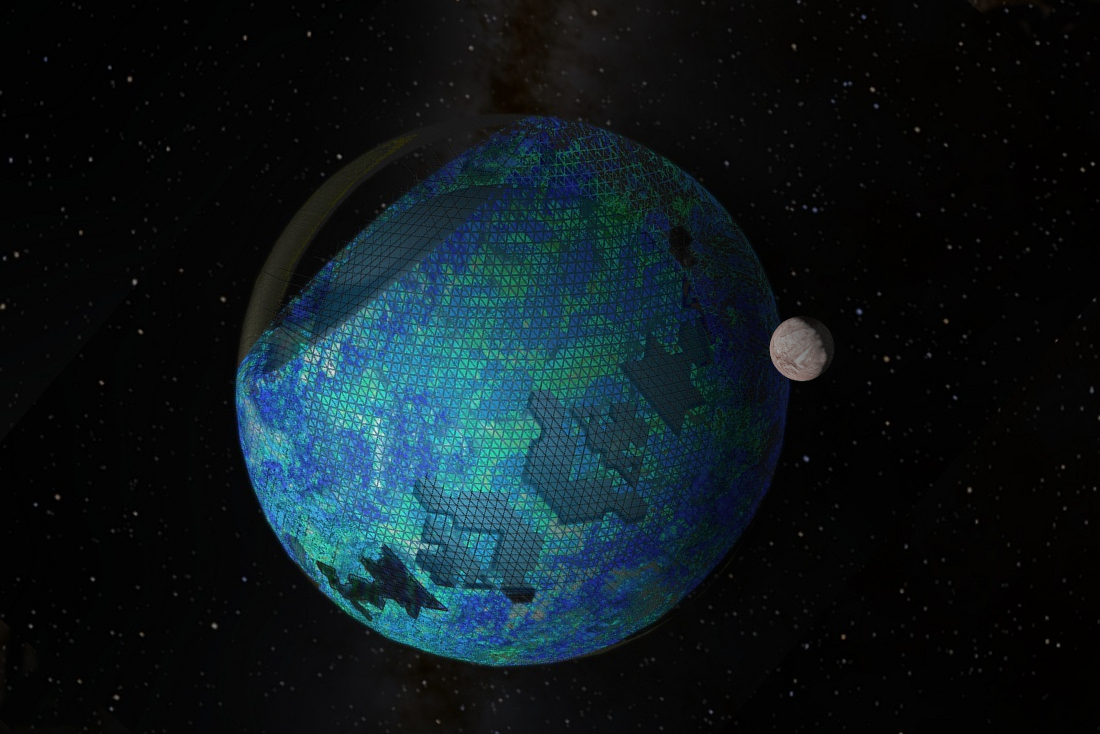
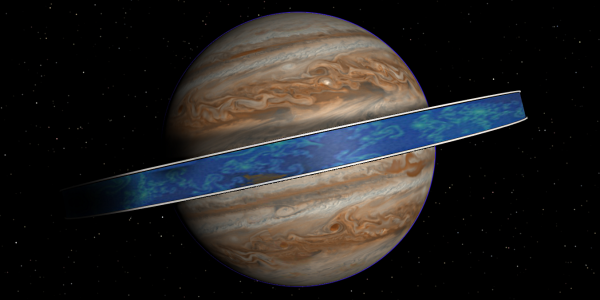
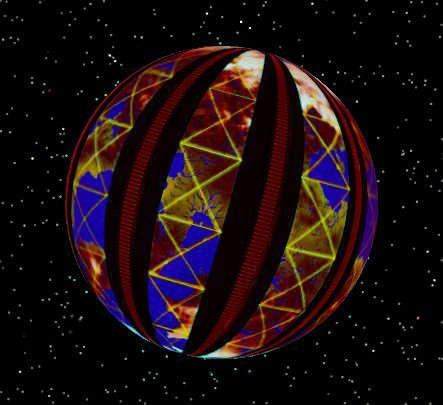
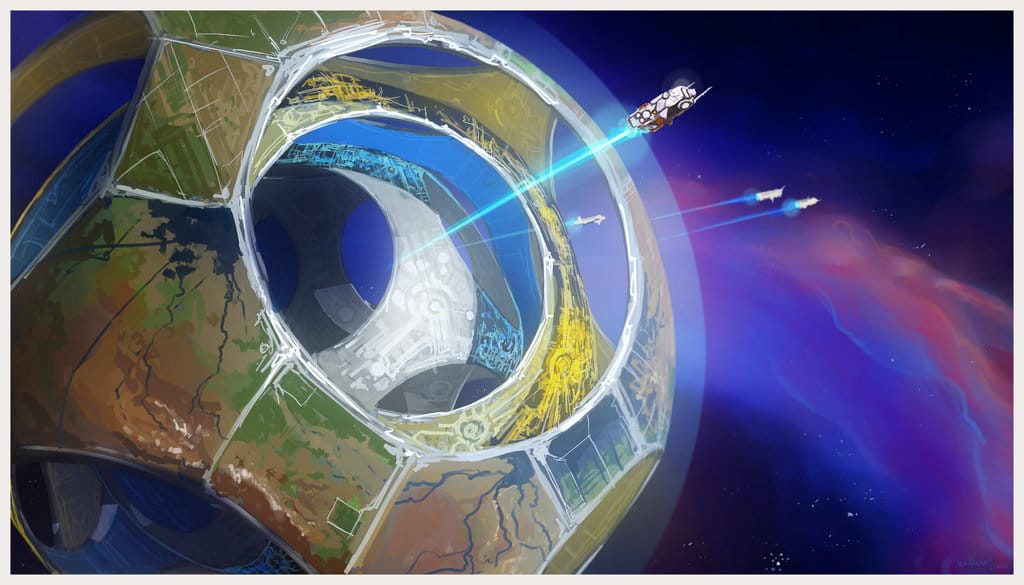
So we've just gone over the first two uses of Gas Giant Refineries which would be, one, to import material into Jovian cities in order to make those cities more "Earth-like" and hospitable to life and, two, to collect Helium-3 and deuterium which will essentially be used as fuel for the second generation of interstellar spaceships. That second point is very important because it will likely be the second generation of interstellar spaceships which will attempt to colonize the Alpha Centuari star system, not the first. But here's a third possible use of Gas Giant Refineries. As we have just discussed, tethers attached to a shell world could be used to extract materials from a Jovian planet. Indeed, this process could be used for millions of years until that Jovian planet's atmosphere had shrunk considerably; in fact, such a process could continue until the entire atmosphere of a Jovian planet is removed. We shall refer to this process as planet lifting since it is very similar to David Crisswell's method of star lifting.
Criswell's method of star lifting would also involve building great big rings around a star; those rings would generate a powerful magnetic field which pumps materials from the star's atmosphere into magnetic rocket nozzles. According to Criswell, after 300 million years, such a process could completely remove the upper-atmosphere of the Sun just leaving its tiny core behind. This tiny core would be a white dwarf star. The star lifting process would have, effectively, converted the Sun from a G-type star into a white dwarf star. In other words, star lifting can be used to transform a star into a different kind of star. This technique would be especially useful to employ towards the end of the Sun's lifetime before it turned into its red giant state which would either burn the Earth to a crisp or reduce our home planet to a whirl of atoms. Instead of using a Shkadov thruster to swap the Sun for a dwarf star, we could just use star lifting to transform the Sun into a dwarf star. In either scenario, we would end up with a star which would live for trillions of more years as opposed to billions. Even after just one billion years, we expect the Sun's luminosity to increase sufficiently to render the Earth uninhabitable for life such as we. This means that even within just the next one billion years, star lifting would be a very nice thing to have to ensure that the Earth remains inhabitable. Thus, the process of star lifting would have modified many physical properties of the Sun (including its color, temperature, brightness, and even its expected lifetime) and, indeed, as we just mentioned, it would have transformed the Sun into a completely different kind of star. We refer to the process of modifying a star's properties as stellar husbandry.
Illustration showing the rocky, icy, metallic cores of the four Jovian planets.
Credit: NASA/Lunar and Planetary Institute
Retrieved from: https://solarsystem.nasa.gov/resources/677/gas-giant-interiors-2003/
It turns out that something analogous happens when we planet lift a gas giant. At the center of most gas giants is a rocky core which you could almost think of as a tiny Earth-like world that is trapped inside of the gas giant's thick and hazy atmosphere. By planet-lifting, you could remove a gas giant's atmosphere and outer layers and, if that gas giant had a rocky, Earth-like core, then after the atmosphere of the gas giant is completely removed what you'd be left with is a rocky, Earth-like planet. By planet-lifting, akin to star lifting, you could transform a gas giant planet into a different kind of planet that is remarkably different. We could refer to this modification of the planet's physical properties as planetary husbandry, akin to the term stellar husbandry which was first coined by David Criswell. Let's say that you find a gas giant planet which has a rocky core at its center and you use planet lifting to convert that planet into an Earth-like planet. Since most gas giants tend to be very far away from their parent star, that Earth-like planet would probably just end up turning into an ice world. But by using something known as Fusion Candles, that entire planet could be moved to its parent star's continuously habitable zone.
The notion of Fusion Candles was discussed in the SFIA episode, Colonizing Jupiter, which discussed moving the planet Jupiter across space. Akin to how a Shkadov thruster positioned next to the Sun would move not just the Sun but also the entourage of eight planets and numerous other bodies which orbit it, as Jupiter moved across space its entourage of moons that orbit it would come with Jupiter for the ride. Such a system of planetary propulsion would allow us to transport Jupiter across interstellar space to another star system. The "fuel" used by these Fusion Candles—namely Helium-3 and Dueterium—would be right there in Jupiter's atmosphere and could be extracted using Gas Giant Refineries. In fact, Jupiter has so much Helium-3 and Dueterium to allow the Fusion Candles to move Jupiter and its moons to a different galaxy. We have, incidentally, discovered rogue planets wandering in the darkness of intergalactic space. Perhaps, one day, our descendants might decide to use such rogue worlds to set sail to another galaxy. They might then go on to colonize that galaxy and, as we discussed in our first video (see video below), could use Shkadov thrusters to move those galaxies and merge them together.
Birch Planets
The infographic above shows the differences between a Type I (or K1), a Type II (or K2), and a Type III (or K3) civilization.
But this would only be doable if they happened to beat the race against universal cosmic expansion which we also discussed in our first video and other lessons, in particular the ones in our Astronomy & Cosmology section. But assuming that they did, they could merge nearby galaxies together using Shkadov thrusters. That should be taken as pretty much a given because, if they do not merge together galaxies, then those galaxies would eventually, after roughly 5 billion years, be moving away from their home galaxy (the Milky Way) faster than the speed of light and, hence, those galaxies would no longer be accessible. Thus, all of the energy and materials contained within those galaxies would be essentially wasted since the K3 civilization couldn't use them in any meaningful way by building artificial habitats, powering their infrastructure, and so on. To put things as simply as possible, there are basically two arguments as to why a K3 civilization should merge together galaxies: one, because they'd have access to a larger number of materials and energies which they could use to extend the lifetime of their species. The second reason is because it would be very wasteful not to merge together galaxies if they could; they'd essentially be "throwing away" a ton of useful energy and material.
This actually brings us to a, in my view, somewhat profound notion: that, namely, the way in which material and energy is distributed across the universe is actually very inefficient, very uneconomic, and very wasteful. That last example is an example of this on the largest scale: the scale of the galaxies. But this can also be noticed on smaller scales. For example, the entire biosphere on Earth and all of human civilization—including our cities, our machines, and ourselves—use only the tiniest fraction of our Sun's output of solar energy; all of the rest of the Sun's energy is basically wasted because that energy is not used in any meaningful way. A far more efficient way to power our biosphere and civilization would be to build a shell world around the Sun (this is known as a Dyson sphere) and to utilize all of the Sun's energy.
My point is that nature has, evidently, not arranged herself with us in mind; artificially built systems are far more efficient than their natural counterparts. Concentric layers of shell worlds are better than planets; a Dyson sphere surrounding a star is better than a star with no Dyson sphere; and having all of the galaxies huddled very close to another using Shkadov thrusters is better than having them recede away from each other faster than the speed of light. The reason why I bring up this point is because we tend to think of a K3 civilization as one which spans hundreds of thousands or millions of lightyears across all of the planets and stars in their galaxy. People tend to think this despite the obvious inefficiencies and problems of a K3 civilization spreading themselves out that thin so to speak; the most obvious problems being the enormous time intervals required for communication and transportation which would likely make it very difficult for such a K3 civilization to cooperate with its members.
A question which we did not address in our video on Shkadov thrusters is what the infrastructure of a K3 civilization would look like after they merged together nearby galaxies? Would they build an expansive empire spanning millions of light years across trillions of stars? The answer is, probably not. This leads to a second question. We've mentioned that Matrioshka worlds (planets surrounded by multiple concentric shell worlds) are better than planets; and Dyson spheres surrounding stars are better than just stars without any megastructures surround them; but is there an artificial system that is superior to an entire galaxy? Yes, there is. This artificial system is known as a Birch Planet. A birch planet is a shell world with a diameter of roughly 1 light year which would concentrically surround a supermassive black hole with a mass of roughly 1.5 trillion times that of the Sun. The shell world would surround that black holes event horizon and have Earth-like gravity. It would be possible to build multiple layers of shell worlds around such a supermassive black hole; by appropriately increasing the mass of each successive shell world, all of those shell worlds could also have Earth-like gravity.
Each shell world would be connected by Atlas towers and tethers. Such a megastructure is the largest possible artificial habitat with Earth-like gravity that could be created according to the known laws of physics because, if such a structure were to be made any larger, the shell worlds would be within the supermassive blackhole's event horizon. If such a megastructure had even just a modest number of layers, then the total surface area of the Birch Planet would exceed the total surface area of all of the planets in the entire Milky Way galaxy. Now that's a pretty mind blowing notion: one planet that has more surface area than the combined surface area of all the billions of planets in our entire galaxy. And that single planet could utilize all of the energy and material of multiple galaxies; thus, what we'd essentially be doing is cramming all of the energy and materials of multiple galaxies into a single artificial planet that is roughly a mere 1 lightyear in diameter. This would allow a K3 civilization to send signals and to transport goods to its most distant members within roughly a year, or maybe several years at most. This would enable the K3 civilization to cooperate as a single unit without splitting off and diverging into separate factions and species.
“We return to the Megastructures series to discuss various ways of creating artificial planets, the special issues with making an Earth-like planet much larger or smaller than Earth, and the maximum size they can be, potentially larger than entire solar systems.”\(^{[28]}\) This video was produced by Isaac Arthur.\(^{[28]}\)
Perhaps it is the destiny of all K3 civilizations to eventually convert their entire galaxy into a single Birch Planet. A Birch Planet would be exceedingly difficult to detect. All of the industrially activity of such a K3 civilization would, of course, produce a lot of heat; but since that light is emitted near the event horizon of a black hole and since it would likely traverse many millions of lightyears of space before reaching us, such a Birch Planet would be almost impossible to detect. And even if we could, since the Birch planet is so small and so distant, we wouldn't know where to look. This is a possible solution to the Fermi Paradox: the apparent contradiction that despite at least one other advanced alien civilization capable of radio communication should have developed, there is not the slightest bit of evidence that there are other civilizations, besides we, that are intelligent and capable of radio communication.
The construction of a Birch planet is technically possible since doing such is well within the known laws of physics. The assumption that a Birch planet needs to have a maximum size limit of 1 lightyear in diameter is true if we want the each shell world to have Earth-like gravity. We could, if we wanted to, make a Birch planet even larger with an even more massive central blackhole; this would result in each Shell world having less gravity than that on the Earth. Now this would be a big problem if we wanted humans to live in these shell worlds. But there's actually a pretty good chance that by time we become a K3 civilization, we will no longer be trapped in "flesh and blood" bodies so to speak. Long before then, humans will perhaps becomes cyborgs and, after that, we'd simply upload our minds into simulations created by computers.
“Would it ever be possible to one day upload our consciousness to a computer? How would we go about this?” This video was created by Seeker.\(^{[29]}\)
It is in fact the belief of the futurist and head engineer of Google, Ray Kurzweil, that sometime during the 21st century we'll upload our minds into a simulated environment created by a computer. Doing this would be possible using any kind of supercomputer, so long as it is powerful enough. This could in principle be done using a Matrioshka brain—a type of supercomputer. Typically, the way that this works is to have shell worlds derive their power from a star; each layer of shells is used to dissipate heat in order to cool the system down. The last layer is used to power circuitry. The entire system acts as an entire supercomputer. Assuming that enough energy could be derived from the supermassive blackhole, then the Birch planet could function as a giant supercomputer like the Matrioshka brain.
This video was produced by Greg School.
As we have discussed in previous articles and video on Shkadov thrusters, the universe is very dangerous in the long run and this incentives any intelligent species to spread more and more outward. Even for an advanced K3 civilization living in a Birch planet, after a long enough time, universal expansion would eventually destroy the Birch planet; and, after a really long time, the atoms themselves will be pulled apart and the universe will die. However, general relativity and quantum mechanics predicts that this isn't the only universe and that we, in fact, live in a multiverse of \(10^{500}\) other universes and that, furthermore, new universes are being spawned all the time. Kip Thorne's work on black holes and general relativity suggests that universes are connected by rotating black holes via wormholes and that some of those wormholes are traversable; meaning, you could travel through them in a spaceship and voyage to another universe. These universes would have different timelines and laws of physics than ours; so a K3 civilization would want to travel to another universe which is very young and one with similar laws of nature as this universe. Maybe then, this process would start all over again. Could they, perpetually, hop from one universe to another and, in this way, live forever? Check out a subsequent article in this series (entitled, String Theory and Colonizing the Multiverse) to find out!
![Artist’s scifi depiction of a galactic empire using portals to travel across space.\(^{[30]}\) Image credit: https://www.deviantart.com/lorddoomhammer/art/Galactic-Network-594726702](https://images.squarespace-cdn.com/content/v1/58757ed7f5e231cc32494a1b/1535350418062-J9E1GDLO69CN0UZRHE4S/gateway_hub_04_by_lorddoomhammer-d9u3226.png)
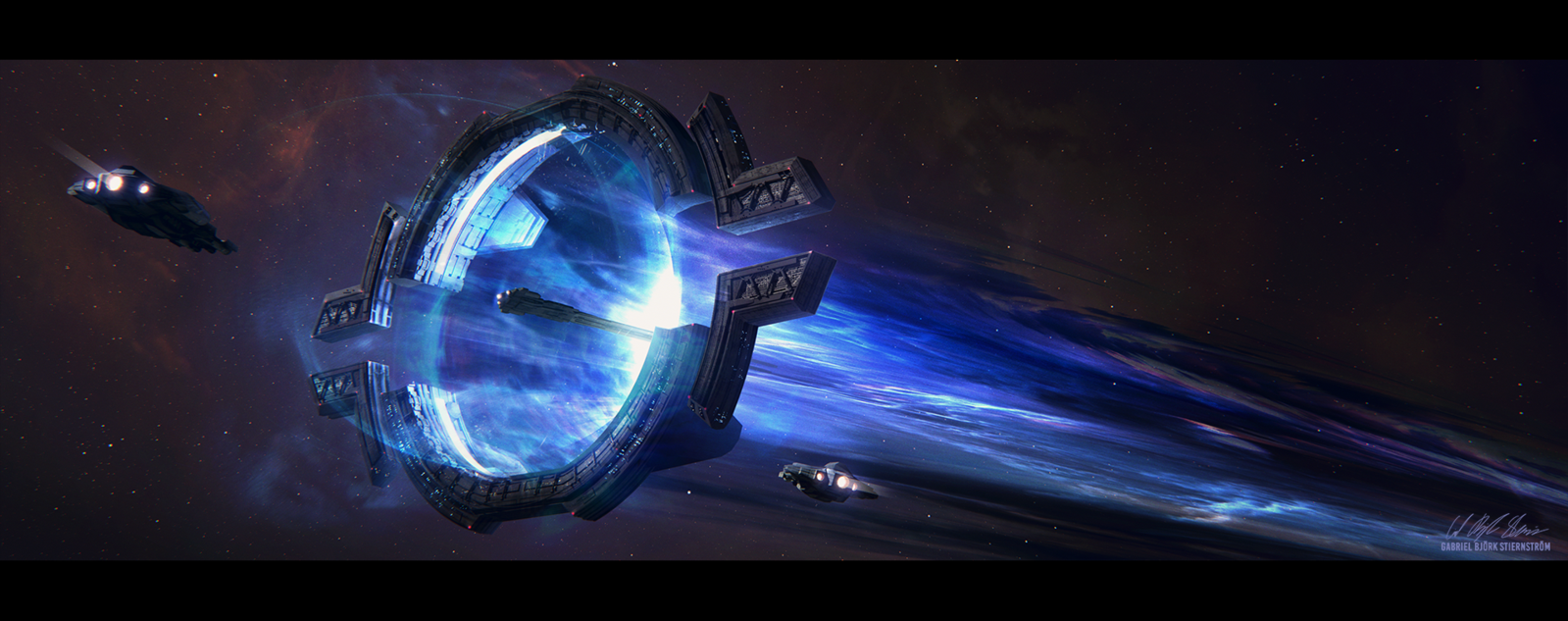
This article is licensed under a CC BY-NC-SA 4.0 license.
References
1. TheLipTV. "Japan’s Obayashi to Build Space Elevator by 2050". Online video clip.
YouTube. YouTube, 23 September 2014. Web. 28 August 2018.
2. ArtStation. (2017). Damocles space elevator hub. [online] Available at:
https://www.artstation.com/artwork/ORg3v [Accessed 28 August 2018].
3. Pearson, J. (1975). "The orbital tower: a spacecraft launcher using the Earth's rotational
energy" (PDF). Acta Astronautica. 2 (9–10): 785–799. Bibcode:1975AcAau...2..785P.
doi:10.1016/0094-5765(75)90021-1.
4. “Space Hotel.” Shimizu, www.shimz.co.jp/en/topics/dream/content04/.
5. CNET. [ca. 2018]. In Facebook [Fan Page]. Retrieved August
29, 2018, from https://www.facebook.com/search/top/?q=space%20hotel
6. ArtStation. (2014). Space Elevators. [online] Available at:
https://www.artstation.com/artwork/NxAlb [Accessed 30 August 2018].
7. Cromer, G. (2017, Auguest). Entretien avec Laurent Queige, directeur Welcome City
Lab. Retrieved from http://prospective-tourisme.com/index.php/2017/08/10/
entretien-laurent-queige-directeur-welcome-city-lab/
8. Isaac Arthur. (2018, April). O'Neil Cylinders. Retrieved from
https://www.youtube.com/watch?v=gTDlSORhI-k
9. Wikipedia contributors. (2018, January 19). The High Frontier: Human Colonies in Space.
In Wikipedia, The Free Encyclopedia. Retrieved 02:19, August 31, 2018, from
https://en.wikipedia.org/w/index.php?
title=The_High_Frontier:_Human_Colonies_in_Space&oldid=821272699
10. Wikipedia contributors. (2018, June 25). O'Neill cylinder. In Wikipedia, The Free
Encyclopedia. Retrieved 02:25, August 31, 2018, from
https://en.wikipedia.org/w/index.php?title=O%27Neill_cylinder&oldid=847435096
11. ArtStation. (2014). Specsheet - O'Neill Cylinder Space Colony Mk.1. [online] Available at:
https://www.artstation.com/artwork/28NNB [Accessed 30 August 2018].
12. xavier, bruno. “Space Colony 2015.” Bruno Xavier's Portfolio, 27 Aug. 2015,
brunoxavierleite.com/2015/08/27/space-colony-2015-5/.
13. Grie, George. Final Frontier Voyager.
14. ArtStation. (2016). Megastructures 7 Star Lifter 1. [online] Available at:
https://www.artstation.com/artwork/rdDlO [Accessed 28 August 2018].
15. Wikipedia contributors. (2018, July 26). 3001: The Final Odyssey. In Wikipedia, The Free
Encyclopedia. Retrieved 02:54, August 31, 2018, from
https://en.wikipedia.org/w/index.php?
title=3001:_The_Final_Odyssey&oldid=852130249
16. David R. Criswell, "Solar System Industrialization: Implications for Interstellar
Migrations," in Interstellar Migration and the Human Experience, ed. Ben R. Finney
and Eric M. Jones (Berkeley: University of California Press, 1985), 58.
17. Isaac Arthur. (2017, June). Orbital Rings. Retrieved from
https://www.youtube.com/watch?v=LMbI6sk-62E
18. Mann, Adrian. “Orbital Ring.” Bisbos, All About Space, n.d., http://www.bisbos.com/
19. Welcome to the Orion's Arm Universe Project. (n.d.). Retrieved from
20. "Orbital Ring Systems and Jacob's Ladders - I", J. Brit. interplan. Soc., 35, 475
(1982)
21. "Orbital Ring Systems and Jacob's Ladders - II", J. Brit. interplan. Soc., 36, 115
(1982)
22. "Orbital Ring Systems and Jacob's Ladders - III", J. Brit. interplan. Soc., 36, 231
(1982)
23. Tesla, N., & Johnston, B. (1919) My Inventions: The Autobiography of Nikola Tesla. City,
New York: Experimenter Publishing Company, Inc.
24. Preuss, A. (n.d.). BROKEN ARMISTICE OVER ABALAKIN [Blog post]. Retrieved
from http://blog.abalakin.de/?page_id=138
25. Isaac Arthur. (2018, January). De-Extinction: Resurrecting the Past. Retrieved from
https://www.youtube.com/watch?v=H581aDWa0ic
26. Tate, Karl. (2013, October). Shell-Worlds: How Humanity Could Terraform Small
Planets. Retrieved from https://www.space.com/23082-shell-worlds-planet-
terraforming-technology-infographic.html
27. Kramer, Miriam. (2013, October). Incredible Technology: How to Use 'Shells" to
Terraform a Planet. Retrieved from https://www.space.com/23063-terraforming-
28. Isaac Arthur. (2017, November). Mega Earths. Retrieved from
https://www.youtube.com/watch?v=ioKidcpkZN0
29. Seeker. (2015, June). Could We Upload Our Consciousness To A Computer? Retrieved
from https://www.youtube.com/watch?v=eqKTdIZIBfU
30. LordDoomHammer. “Deviant Art.” Deviant Art, 2016,
www.deviantart.com/lorddoomhammer/art/Galactic-Network-594726702.
31. GabrielBStiernstrom. "Deviant Art." Deviant Art, 2017,
https://www.deviantart.com/gabrielbstiernstrom/art/Hades-Star-Warp-Lane-Hub-
Other Sources
32. Heppenheimer, T. A. Colonies in Space: a Comprehensive and Factual Account of the
Prospects for Human Colonization of Space. Stackpole Books, 2017.
33. Kaku, Michio. The Future of Humanity: Terraforming Mars, Interstellar Travel,
Immortality, and Our Destiny beyond Earth. Allen Lane, 2018.
Notes
1. The concept of the Ocean Spiral was first unveiled by Shimizu Corporation, in conjunction with Tokyo University and the Japan Agency for Marine-Earth Science and Technology, in 2014. The company excepts it to take 5 years to build an Ocean Spiral. The company expects the project to cost ¥3 trillion (approximately £20 billion). The company claims it could be ready for human habitation by 2030. Learn more by reading the article, Ocean Spiral is a conceptual city proposed beneath the surface of the ocean.


![espen-saetervik-rings[2].jpg](https://images.squarespace-cdn.com/content/v1/58757ed7f5e231cc32494a1b/1535427180632-YR8Q7WRXI3UBS75KUP4V/espen-saetervik-rings%5B2%5D.jpg)




![Artist’s depiction of an O’Neil cylinder. Artwork by Bruno Xavier . \(^{[12]}\)](https://images.squarespace-cdn.com/content/v1/58757ed7f5e231cc32494a1b/1535346333981-HJP31EH0IUYOX5I309KF/space-colony-ix.png)
![13220830_239617033095862_8671672187626094751_n[1].jpg](https://images.squarespace-cdn.com/content/v1/58757ed7f5e231cc32494a1b/1535568389104-6GFQC9YL8FXZ9COJ53AH/13220830_239617033095862_8671672187626094751_n%5B1%5D.jpg)

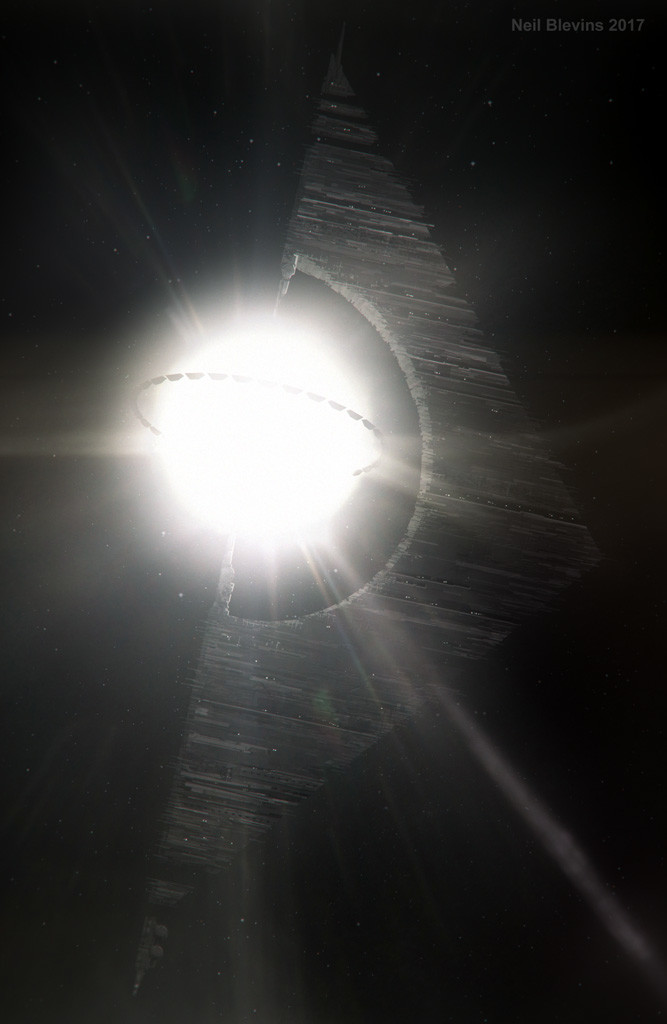



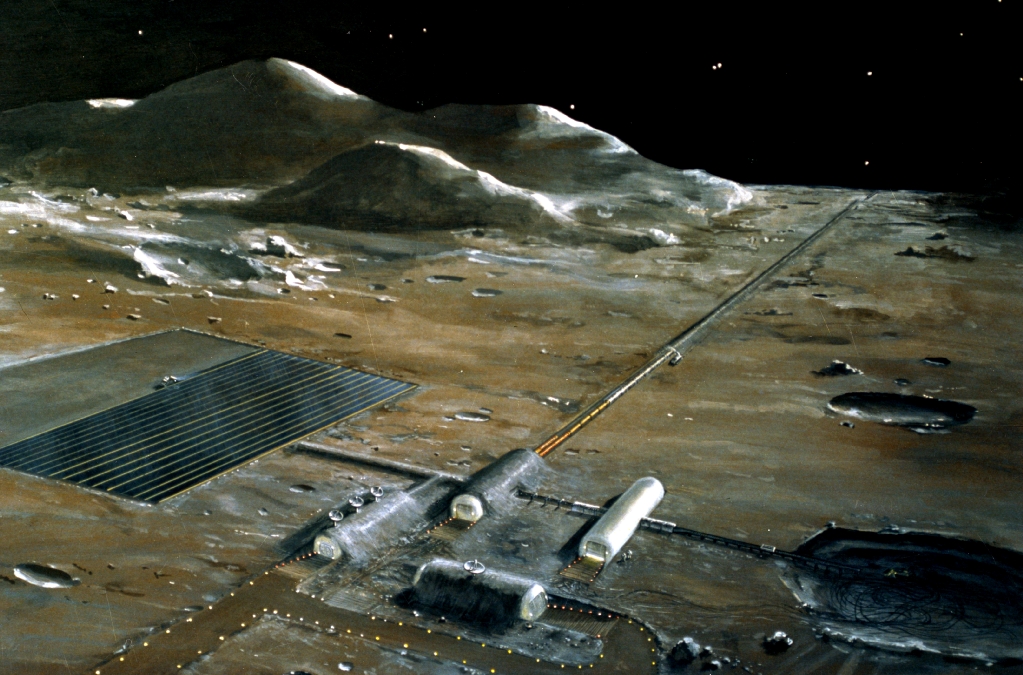
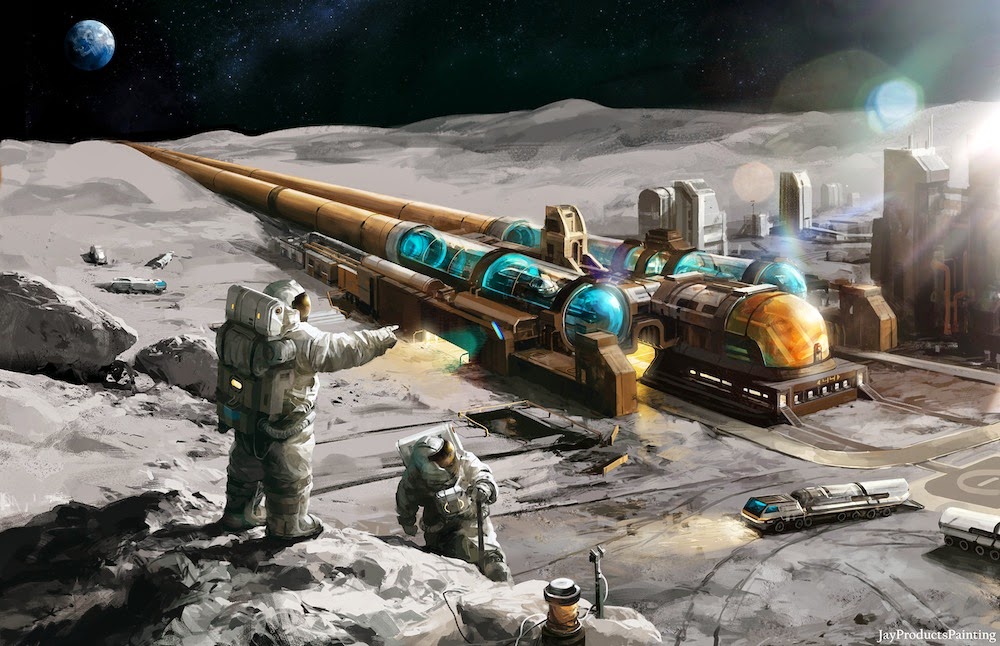
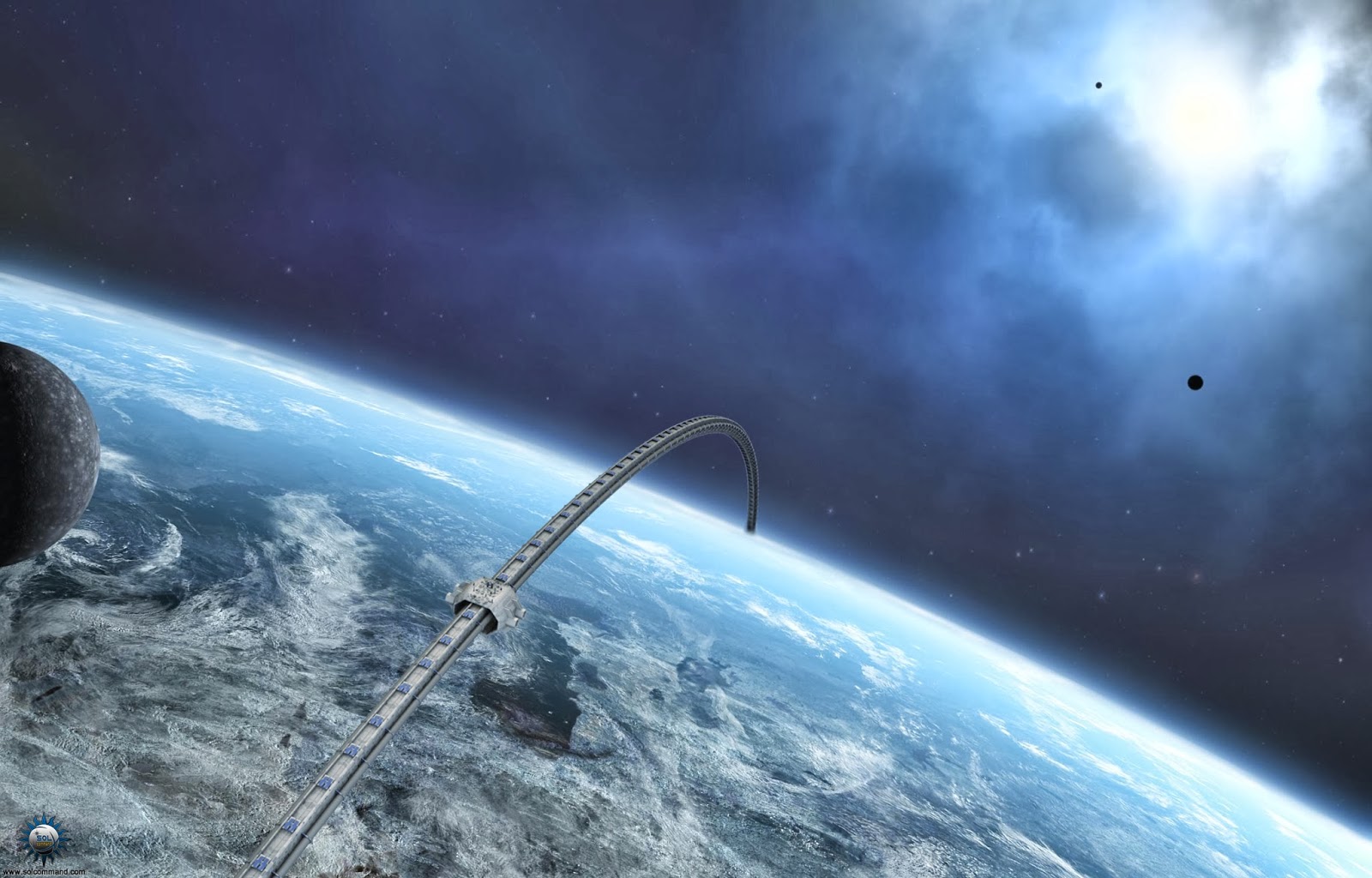

![Artist’s depiction of an orbital ring which appeared in Issue 7 of the magazine, All About Space . Image by Adrian Mann .\(^{[18]}\)](https://images.squarespace-cdn.com/content/v1/58757ed7f5e231cc32494a1b/1535353869701-ZL3EXSSSIVTLUNA9RZYR/earthring_1024.jpg)
!["The inner and outer static orbital rings around Bronx are linked to a central geostationary ring by carbon nanotube cables. The inner ring is only 265km above the clouds, while the outer ring is 75,600km from the planet's core."\(^{[19]}\) Image fr…](https://images.squarespace-cdn.com/content/v1/58757ed7f5e231cc32494a1b/1535355713910-0NBISP789OYJWK692OGF/med_bronx4.jpg)



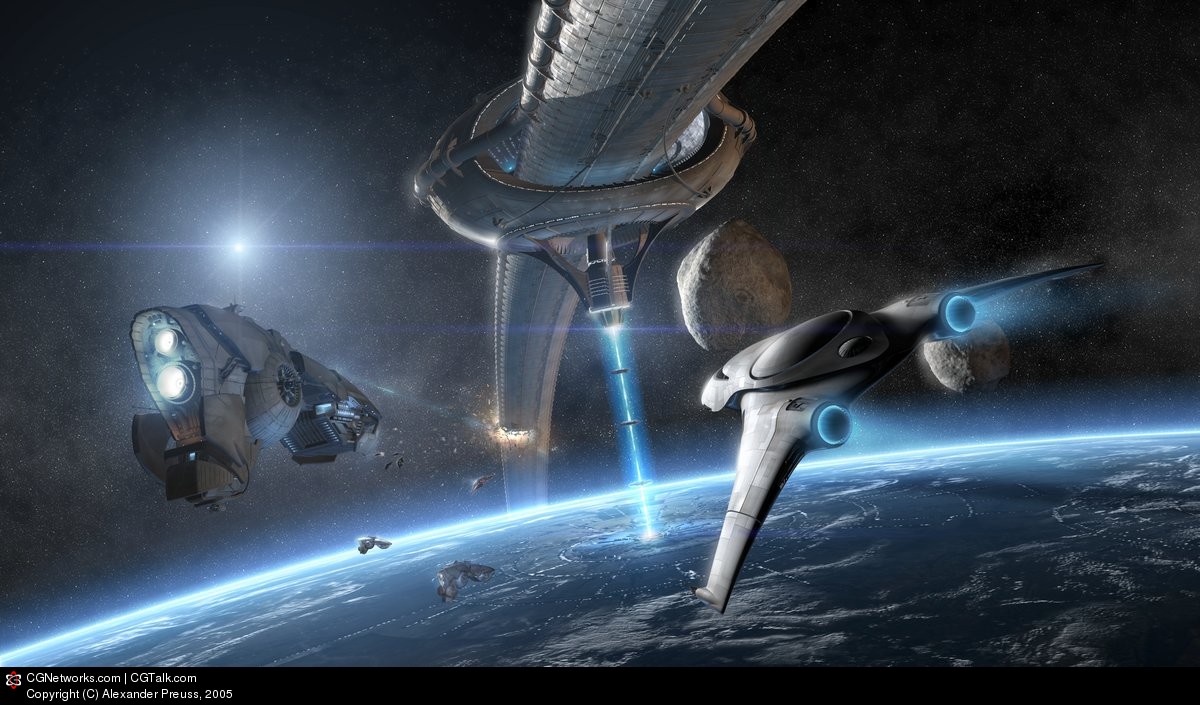
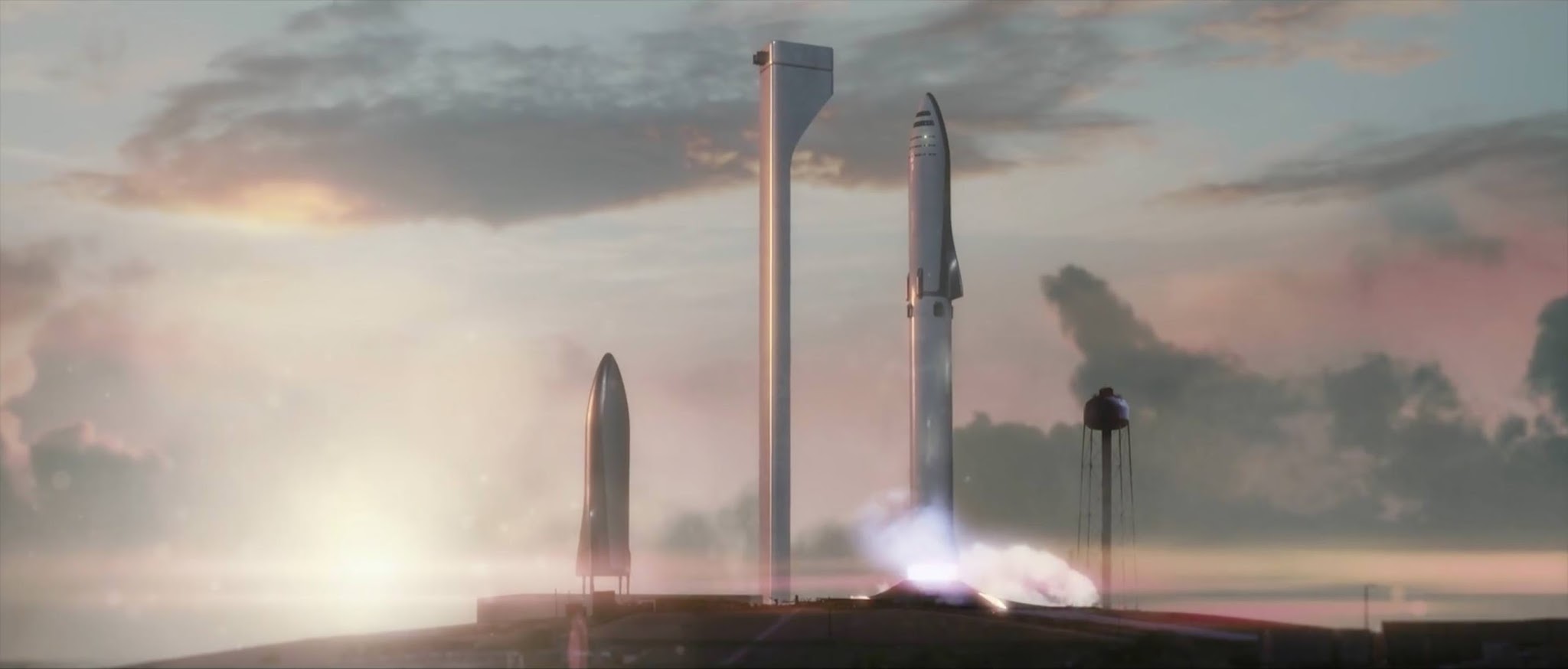

![EeJcpqLjdfReW4kJ22xE_Shimizu3[1].jpg](https://images.squarespace-cdn.com/content/v1/58757ed7f5e231cc32494a1b/1535505601058-LZ6VDDW8MH3DQYYMXKHR/EeJcpqLjdfReW4kJ22xE_Shimizu3%5B1%5D.jpg)
![1016944456[1].jpg](https://images.squarespace-cdn.com/content/v1/58757ed7f5e231cc32494a1b/1535505605926-29C21G7KZBNOTVL8S92A/1016944456%5B1%5D.jpg)
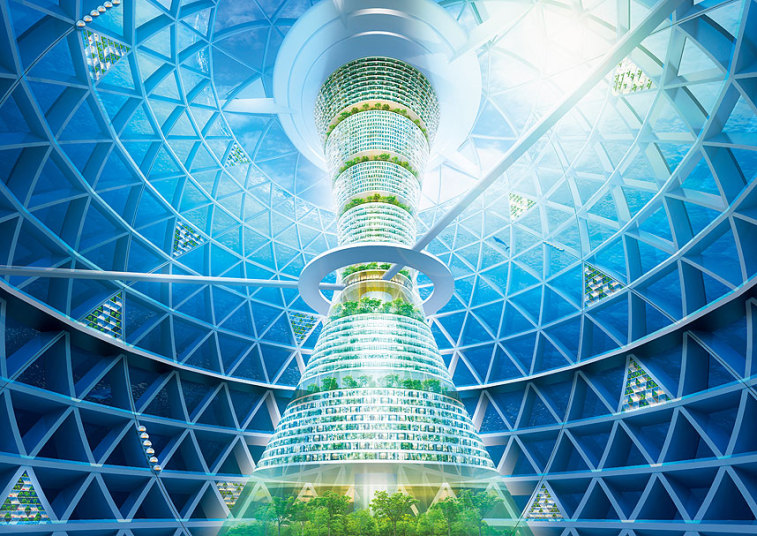
![3N0rREtorxM8g6vSXCRG_Shimizu5[1].jpg](https://images.squarespace-cdn.com/content/v1/58757ed7f5e231cc32494a1b/1535505934930-3T38LQF168ZYLXM0N7O7/3N0rREtorxM8g6vSXCRG_Shimizu5%5B1%5D.jpg)
![tP0RZDSgdsNPw8Z245OD_Shimizu7[1].jpg](https://images.squarespace-cdn.com/content/v1/58757ed7f5e231cc32494a1b/1535505945093-XWQQX5NXYJXO3R6KGL15/tP0RZDSgdsNPw8Z245OD_Shimizu7%5B1%5D.jpg)
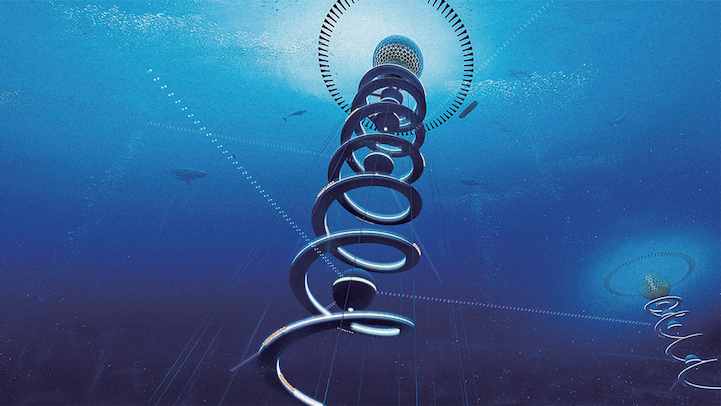

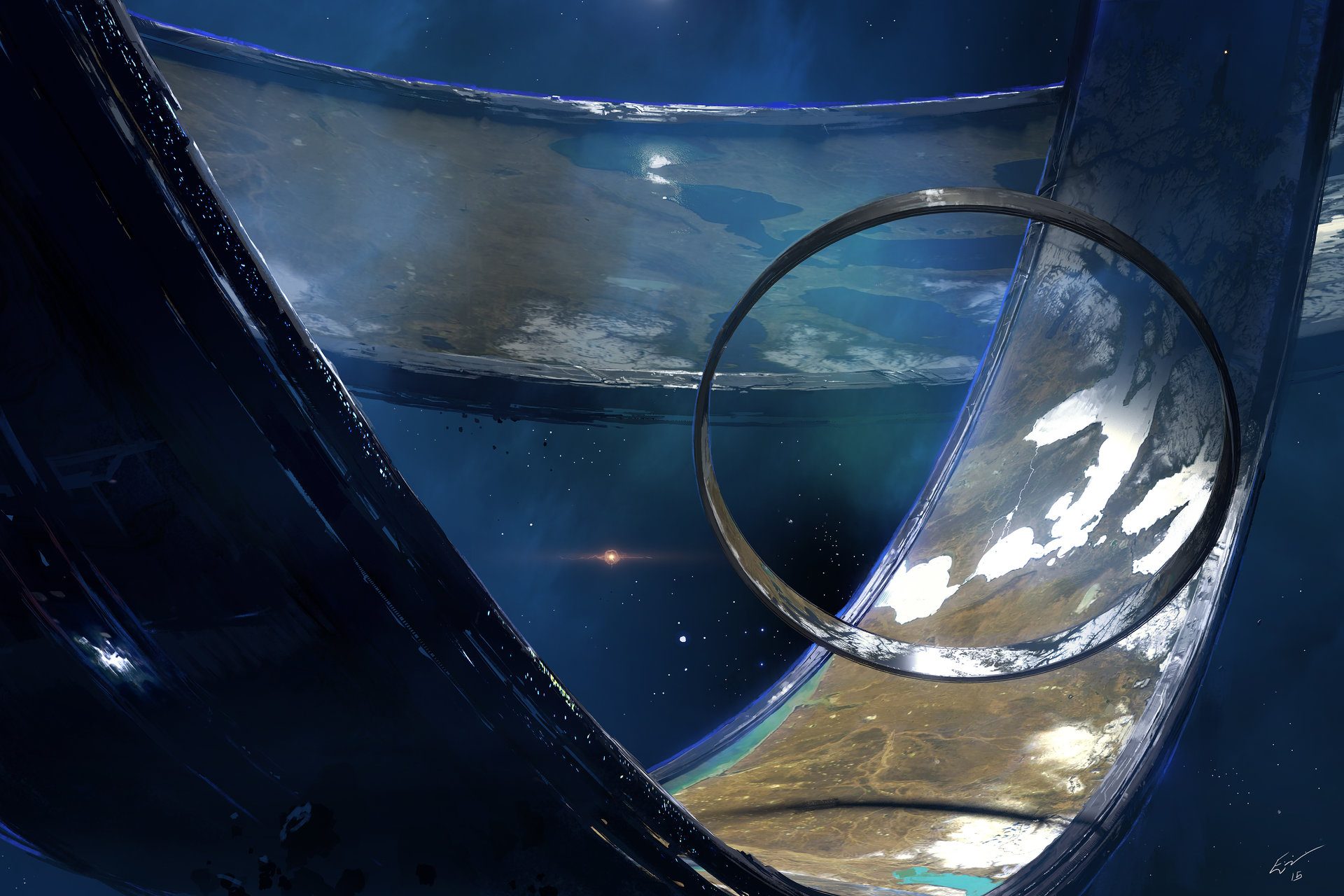
!["Full cities could hang from the top of the shell that holds in the newly terraformed world's atmosphere."\(^{[27]}\) Image uploaded Oct. 7, 2013.Credit: Ken Roy/Tennessee Valley Interstellar Workshop](https://images.squarespace-cdn.com/content/v1/58757ed7f5e231cc32494a1b/1533003070433-9WWGEWY0VDQ1P4R5LXU8/cities+dangling+from+shell+world.jpg)
